#Tribute to Dante Alighieri
Explore tagged Tumblr posts
Text
Omaggio a Dante: gli incunaboli della Divina Commedia
ossia le preziose edizioni stampate fra il 1470 e il 1502 di Alessandro Ferrini Il poema di Dante ebbe subito un successo grandioso, lo testimoniano gli oltre seicento manoscritti circolati nel XIV secolo, subito dopo la morte del poeta. Editio Princeps della Divina commedia, stampata a Foligno nel 1472 Quando fra gli anni ’60 e ’70 del Quattrocento i tipografi tedeschi introdussero la…

View On WordPress
#Divina Commedia: preziose edizioni stampate fra il 1470 e il 1502#Gli incunaboli della Divina Commedia#Omaggio a Dante nel 750° anniversario#Tribute to Dante Alighieri
0 notes
Note
IM BRAINROTTING ON THE OBEY ME CAST AS FATHERS,
how would they name their children???😩😩😩
how the obey me brothers would name their children

disclaimer; these are my personal headcanons, feel free to tell which names you liked the most!
edit;;i posted the side characters version too! go check it out if you want <//3
genre; fluff

lucifer;
lucifer would either name the baby with a variation of his name, or homage somebody or something dear to him
if it’s a boy, lucian or lucius. both names means light, if it’s a girl, he would call her lilith. danica is a second option: the name means morning star.
mammon;
he would either name his baby after something expensive. another option is mashing up your names together
if it’s a boy he would go for midas, which means touch of gold, or straight up fortune,
if its a girl, esmeralda which means emerald. or diamond, the name speak for itself.
leviathan;
definitely name his baby to reference something he likes. some people may think he would name his children after an anime character he likes, but that is not the case
if it’s a boy, henry without a doubt, the name means house ruler. he would also like christopher, to simeon’s joy, which means bearing christ. very very ironic.
if its a girl, mira, which means ocean. he also likes umiko, a japanese name that means child of the sea.
satan;
he takes inspiration from human literature and would name his baby after a character or author he particularly likes.
if it’s a boy, william which means protection and desire. he chose it because of william sherlock scott holmes, probably the most famous fictional detective in the history of literature, it’s also a reference to shakespeare. another boy name is dante which means everlasting, after the italian poet dante alighieri, that wrote “the divine comedy”, which is set in heaven, purgatory and then hell.
if it’s a girl he would name her juliet which means youthful, another tribute to shakespearen literature. emma, after jane austen’s book, is also a name he likes, it’s means whole or universal.
asmodeus;
he only choose the name if it’s pretty. often goes for floral and fancy names that sound aesthetically pleasing to him.
if it’s a boy, narciso which means of narcissus, named after the myth.
he briefly considered cupid but he threw away the idea and choose a simple but pretty name like prince, which means royal son.
if it’s a girl, regina which means queen, or bellerose which means beautiful rose.
beelzebub;
he is a family-oriented person, and will try to pass his values to his children.
if it’s a boy, titan which means defender. despite being the name of a fruit, he also likes açaí which means weeping fruit.
if it’s a girl, ohana which means family in hawaiian, another name he consider is belarmina which means beautiful armor, he choose it because it’s starts with ‘bel’, just like his and belphegor’s name.
belphegor;
big fan of space-related names, it’s even easier for him since there are a lot of stars and constellations he can get his inspiration from. like lucifer, he would also try to pay homage to lilith.
if it’s a boy, sirius which means glowing, named after the brightest star in the earth’s night sky. he also likes badar which means full moon.
if it’s a girl, a name variation of lilith, something like lilithe or just lili. he also likes alrisha, one of the brightest star of the pisces constellation, since pisces is his and beelzebub’s zodiacal sign.

#obey me#obey me x mc#obey me x reader#obey me headcanons#obey me brothers#obey me lucifer#obey me lucifer x reader#obey me lucifer x mc#obey me mammon#obey me mammon x reader#obey me leviathan#obey me leviathan x reader#obey me satan#obey me satan x mc#obey me satan x reader#obey me asmo#obey me asmodeus#obey me asmodeus x mc#obey me asmodeus x reader#obey me asmo x reader#obey me beelzebub#obey me beelzebub x reader#obey me beel x reader#obey me belphegor#obey me belphagor x reader#obey me belphie#obey me diavolo#obey me barbatos#obey me simeon#obey me solomon
566 notes
·
View notes
Video
vimeo
SelfieMuseum.Art presents STEFANO FAKE & THE FAKE FACTORY -ANGEL WINGS- (2020).mp4 from the fake factory on Vimeo.
FAKE “ANGEL WINGS” (2020)
This mural created by FAKE in collaboration with Adrien Berlin is a tribute to the concept of an angel-woman, of which the late medieval poetry of the Dolce Stil Novo was a relevant subject. The sweet Stil novo has at its center the figure of the angel woman from whom poets draw inspiration. The woman is not described as an earthly figure but as a mystical creature who is sublimated in the verses of the Stilnovo poets.The figure of the woman-angel, which has a fundamental role in Stilnovo poetry, is not an invention of this current and was, indeed, very present in the previous poem in which, however, the analogy between the woman and the celestial entity was limited to a comparison based on aesthetic factors. Stilnovists rethink this figure in a totally new way, more spiritual than aesthetic. The beauty of the woman-angel is identified by Stilnovists as a beauty coming from God and therefore rich in every virtue, which arouses in the man who has a noble heart a feeling of Love that should not be identified with carnal desire, but must be understood as a means of improvement which, through an almost mystical experience, can perfect and elevate one's soul. The first description of the woman-angel in this key ("d'angel sembianza") is found in the sonnet Al cor gentil rempaira semper amor by Guido Guinizzelli, considered as a true manifesto of Stilnovo poetry. This female archetype becomes an instrument of divine action, acting on a level that is almost supernatural.
Guido Cavalcanti, Lapo Gianni, Cino da Pistoia and Dante Alighieri are among the greatest exponents of Tuscan stilnovism. The description of the female figure is characterized by a rigorous process of abstraction in which the lover conceives the very idea of beauty from the external image of the angel-woman.
--
Questo murales realizzato da FAKE nel 2020 è un omaggio al concetto di donna-angelo, di cui la poesia tardo medievale del Dolce Stil Novo era soggetto rilevante. Il dolce Stil novo ha al centro la figura della donna angelo da cui i poeti traggono ispirazione. La donna non viene descritta come una figura terrena ma come una creatura mistica che nei versi dei poeti stilnovisti viene sublimata. La figura della donna-angelo, che ha un ruolo fondamentale nella poetica stilnovista, non è un’invenzione di questa corrente ed era, anzi, ben presente nella precedente poesia nella quale, però, l’analogia tra la donna e l’entità celeste era limitata a un paragone basato su fattori estetici. Gli stilnovisti ripensano questa figura in modo totalmente nuovo, più spirituale che estetico. La bellezza della donna-angelo viene identificata dagli stilnovisti come una bellezza proveniente da Dio e quindi ricca di ogni virtù, che suscita nell’uomo che ha un cuore nobile un sentimento d’Amore che non va identificato con il desiderio carnale, ma va inteso come un mezzo di perfezionamento che, attraverso un’esperienza quasi mistica, può perfezionare ed elevare il suo animo. La prima descrizione della donna-angelo in questa chiave (“d’angel sembianza”) si ritrova nel sonetto "Al cor gentil rempaira sempre amor" di Guido Guinizzelli, considerato come un vero e proprio manifesto della poesia stilnovista. Quest’archetipo femminile diventa uno strumento dell’azione divina, agisce su un piano che è quasi soprannaturale. Guido Cavalcanti, Lapo Gianni, Cino da Pistoia e Dante Alighieri sono tra i massimi esponenti dello stilnovismo toscano. La descrizione della figura femminile si caratterizza per un rigoroso processo di astrazione in cui l'innamorato concepisce l'idea stessa della bellezza dall'immagine esteriore della donna-angelo.
----
FAKE 在 2020 年创作的这幅壁画是对天使女性概念的致敬,其中 Dolce Stil Novo 的中世纪晚期诗歌是一个相关主题。 甜美的 Stil novo 以天使女人的形象为中心,诗人从中汲取灵感。这个女人不是被描述为一个尘世的人物,而是一个神秘的生物,在 Stilnovo 诗人的诗句中得到了升华。在斯蒂尔诺沃诗歌中起着重要作用的女性天使的形象并不是这一潮流的发明,而且确实在前一首诗中非常存在,然而,在这首诗中,女性与天体之间的类比是仅限于基于审美因素的比较。 Stilnovists 以一种全新的方式重新思考这个人物,比审美更精神。女性天使的美丽被斯提尔诺夫主义者认定为来自上帝的美丽,因此具有丰富的美德,它在拥有高尚心灵的男人心中唤起一种爱的感觉,���种爱不应等同于肉欲,而必须是被理解为一种改善的手段,通过一种近乎神秘的体验,可以完善和提升一个人的灵魂。 这首曲子中对女性天使的首次描述(“d'angel sembianza”)出现在 Guido Guinizzelli 的十四行诗“Al cor gentil rempaira semper amor”中,被认为是 Stilnovo 诗歌的真正宣言。这种女性原型成为神圣行动的工具,在几乎超自然的层面上行动。 Guido Cavalcanti、Lapo Gianni、Cino da Pistoia 和 Dante Alighieri 是托斯卡纳 stilnovism 最伟大的代表人物。女性形象的描述以严格的抽象过程为特征,在这个过程中,情人从天使女人的外在形象中构思出美丽的概念。
---
2020년 FAKE가 제작한 이 벽화는 돌체 스틸 노보(Dolce Stil Novo)의 중세 후기 시가 관련 주제였던 천사 여성의 개념에 대한 찬사입니다. 달콤한 Stil novo는 그 중심에 시인들이 영감을 얻는 천사 여인의 모습을 가지고 있습니다. 여인은 지상의 인물이 아니라 스틸노보 시인의 시에서 승화되는 신비로운 존재로 묘사됩니다. Stilnovo 시에서 근본적인 역할을 하는 여성 천사의 모습은 이 흐름의 발명품이 아니며 실제로 이전 시에 매우 존재했지만 여성과 천체 사이의 비유는 미적 요인에 근거한 비교로 제한됩니다. Stilnovists는 이 수치를 미학적이라기보다 영적인 완전히 새로운 방식으로 다시 생각합니다. 여자 천사의 아름다움은 Stilnovists에 의해 신에게서 오는 아름다움으로 식별되므로 모든 미덕이 풍부하여 고귀한 마음을 가진 남자에게 육체적 욕망과 동일시되어서는 안 되는 사랑의 느낌을 불러일으킵니다. 거의 신비로운 경험을 통해 자신의 영혼을 완성하고 향상시킬 수 있는 개선의 수단으로 이해됩니다.
0 notes
Text
Italy pays tribute to Dante with national day
Italy celebrates Father of the Italian language. Italy marks the fourth edition of Dantedì, the national day dedicated to Dante Alighieri, on Saturday 25 March. The annual event in honor of the mediaeval poet and philosopher – known as the Father of the Italian language – follows the 700th anniversary of his death two years ago. A program of Dante-themed events will take place across Italy on the…

View On WordPress
0 notes
Text
Schiaparelli’s ‘Inferno’: A journey to Hell and back
I’ve always wondered if today’s self-absorbed creative directors and edgy designers at the leading luxury fashion houses based in Paris are familiar with George Santayana’s cutting observation that, “Fashion is something barbarous, for it produces innovation without reason and imitation without benefit.” On the evidence of this year’s Paris Fashion Week I think not.
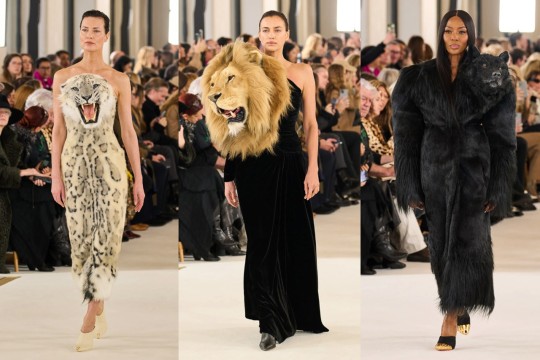
For the Spring 2023 collection at Paris Fashion Week, Schiaparelli creative director Daniel Roseberry revealed in pre-show notes that he was specifically drawn to Dante Alighieri’s magisterial Divine Comedy. He was especially inspired by Inferno, the 14th-century Italian poet’s renderings of Hell. Present as spectators and models were some of the internet’s favourite muses, such as Kylie Jenner wearing taxi-dermied outfits with hyperrealistic faux animal heads affixed to a fitted gown.

The singer Doja Cat was also there, appearing bald and covered in red gemstones at the steps of the Petit Palais like a demonic red figure. In other pieces, gold-painted torsos and metallic sculptural heads paid tribute to the house’s founder, Elsa Schiaparelli, and her ties to Surrealist artists like Man Ray, Salvador Dalí, and Meret Oppenheim during the 1930s. She was the subject of a recent retrospective at the the Musée des Arts Décoratifs in Paris last year in 2022, and her collaborations with those artists demonstrated a propensity to shock audiences with strange garments that at times merged human bodies with animal features.
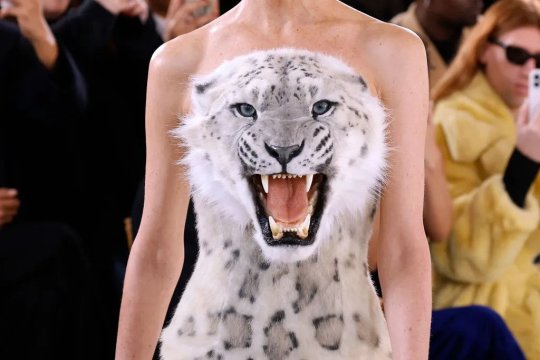

Throughout the haute couture show, Roseberry brought to life versions of Dante’s epic poem’s three allegorical animals: the lion, the leopard, and the she-wolf. Accordingly he dressed three super models, Shalom Harlow as the leopard, Naomi Campbell as the she-wolf, and Irina Shayk as the lion. All three haute couture dresses were sculpted and embroidered by hand, “celebrating the beauty of nature and guarding the woman who wears it” said the proud creative director.
When I read that particular remark I almost choked on my tea. I was sitting in a nearby Parisian café with my younger sister, who was visiting me in France, and one of our French-Nordic cousins who actually works in the luxury brand corporate world as a senior exec in LVMH. Through our cousin we had managed to see one or two of the fashion shows last week. It’s not really my cup of tea, but I gave in to indulge my visiting sister and my cousin who loves her job.
Many people outside of haute couture world of Paris Fashion Week, focused on the spectacle of cruelty of seeing three stuffed animal heads on the bosoms of three super models strutting on a fashion show runway. Most of the criticism was misplaced as it showed little understanding what a haute couture show is all about. It allows the talented designer to let his/her hair down and show off their most off the wall ideas, and above it’s meant to be playful.
That said, I, however, was focused on what Daniel Roseberry actually said of his collection. I thought it was a misquote but no, as it turned out later, it’s what the designer said.
I resisted the urge to feel ‘offended’ and to look around for a pitch fork to join the unruly easily offended mob to denounce the designer. To me it wasn’t about the Surrealist heritage of Schiaparelli that the creative director drew inspiration from for one part of his show - that’s what one might expect from that fashion house. Nor was it the animal depiction on dress gowns that was pretty par for course for any haute couture fashion show - which I personally found garish and in bad taste - but which drew the public outcry against the perception of animal cruelty.
No, it was the crime of cultural vandalism against Dante himself.

I have no idea if Roseberry has actually read the Dante’s Divine Comedy or not but from his remarks that his hideous creations were “celebrating the beauty of nature and guarding the woman who wears it” he clearly hadn’t or was high as a kite on drugs and high energy drinks.
So I’m going to discuss Dante’s three wild beasts as Dante wrote them.
In the opening Canto of the Divine Comedy, Dante encounters three ferocious animals: the leopard, the lion and the she-wolf.

In the first canto of the Inferno, Dante, having gone astray in a dark wood, reaches the base of a sunlit hill (later described by Virgil as “the mountain of delight, the origin and cause of every joy”) and begins to climb - only to find the way blocked by three beasts. First, a leopard appears.
And almost where the hillside starts to rise - look there! - a leopard, very quick and lithe, a leopard covered with a spotted hide. He did not disappear from sight, but stayed; indeed, he so impeded my ascent that I had often to turn back again.
It is a spring morning, and “the hour and the gentle season” give Dante “good cause for hopefulness” upon seeing the leopard - but then he sees a lion.
but hope was hardly able to prevent the fear I felt when I beheld a lion. His head held high and ravenous with hunger - even the air around him seemed to shudder - this lion seemed to make his way against me.
When the third beast appears, Dante gives up hope entirely.
And then a she-wolf showed herself; she seemed to carry every craving in her leanness; she had already brought despair to many. The very sight of her so weighted me with fearfulness that I abandoned hope of ever climbing up that mountain slope. . . . I retreated down to lower ground.
When you read Dante - in Italian or in translation - nothing you read ever so simple and nothing should be taken at face value. Indeed in the Divine Comedy almost nothing is said without good reason. Take the verse preceding the appearance of the three beasts.
When I had rested my body there a while I then started again up the barren slope the more powerful foot always behind the other
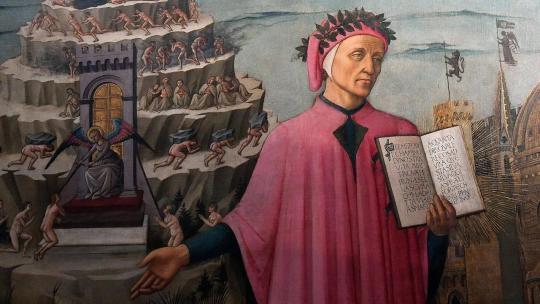
Dante refers to the manner of his climb. He makes the climb with ‘the more powerful foot always behind the other’. One foot (the more powerful) is always behind (lower than) the other. This is a difficult line to interpret. It could of course simply be a description of how someone climbs a hill. You plant one foot in the ground and then push up allowing the other foot to 'land' and secure your position.
If Dante is talking about a stronger (firmer) foot and (presumably then) a weaker foot and talks about the one being lower than the other, there is probably a deeper meaning behind it. In Dante's thought world it was sometimes said that in the 'pilgrimage' towards heaven, we walk on two 'feet' (or legs); the Will and the Intellect. Because the Will, the stronger of the two, is always desiring what it shouldn't, our journey forward towards God is therefore hampered. We limp our way to heaven! So Dante could be saying that his Will lags behind his Intellect as he strives to find the light of God, making his journey up those slopes that much harder. The (weaker) Intellect is having to drag the (stronger) Will upwards towards the divine light.
An alternative explanation is inspired by a comment from St Augustine to the effect that 'love is the foot of the soul', in other words the driving force of the soul's quest for God. So, Dante could be suggesting that his stronger foot (love) pushes his body up the hill towards God. Personally I prefer this more optimistic image of his ascent; after all, he begins his climb in hope and anticipation.
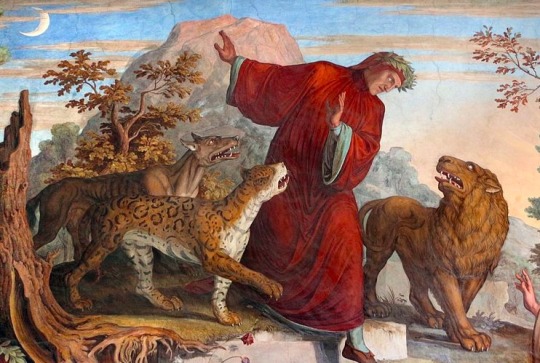
And so we have to ask ourselves as we come to the three beasts, is there a deeper meaning to these animals beyond their physical power and scariness. Yes, there is.
When Dante engages with myths throughout his Inferno, he’s also leaning into this tradition of animals as allegories. He’s striving to teach a lesson, as mythical creatures punish sinful souls for eternity. Invoking creatures from antiquity, Dante’s Inferno moulds pagan hell into a Christian design. These mythical creatures are behemoth reminders for potential sinners about the consequences of their actions.
Even from the opening canto of Dante’s Inferno, we find our titular character lost in a dark and winding wood. As the woods darken, he feels his consciousness enter a strange state - a feeling that he likens to death (Inferno 1.7). As this shroud covers him, Dante encounters the first mythical creatures in the Divine Comedy. Leopards and lions were not native to Italy. Travellers relayed tales of these beasts to illuminators and scribes, and information about them would be published in bestiaries. Leopards were often incorporated into coats of arms when there were descendants of adultery in a lineage. The leopard Dante encounters is “very quick and lithe” (Inferno, 1.32). Perhaps the leopard is meant to symbolise a sin associated with impatience or hubris. Lions were often symbols of Christ, akin to Aslan in the Chronicles of Narnia but in this case the lion was “ravenous with hunger” (Inferno 1.46), which may have been a reminder to the reader about the dangers of gluttony.
The importance of animals goes beyond face value. Animals appearing in stories always contain allegories. The beasts symbolised the major categories of sin: incontinence, violence and fraud. Or as they are more commonly called - lust, pride and avarice. In her commentary, Dorothy L. Sayers explains that these categories of sin were associated with the three stages of life - lust with youth, pride (self-conceit) with the middle years and avarice with old age. Of course, they can attack a person at any time of his life.
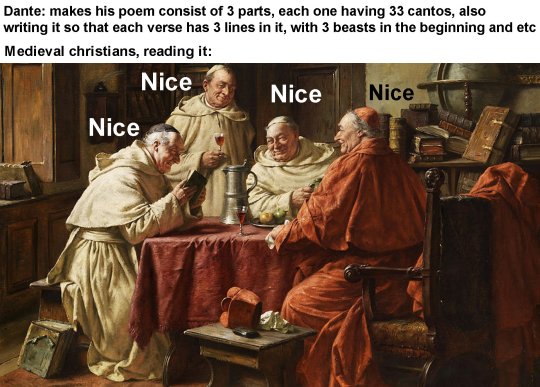
Symbolism can help us enormously when reading Dante but it is also important I think to try to read the text itself and take clues from the way Dante uses the symbols. The Leopard is mesmerising, clever, quick and very pleased with itself, displaying its gaudy spots for all the world to see. The Lion terrifies even the air around it with its appearance (and presumably its roar) but the most noticeable thing about it from Dante the pilgrim's point of view is how proud it is as it hold its head up high. The third beast, the she-wolf, is one that has brought grief to many people. Her leanness speaks of an insatiable appetite; no matter how much (or how many people!) she eats she never thrives, never grows fat, she is never satisfied.
If Dante's world each of the beasts represented different vices or sins - the leopard as a symbol of lust, the lion a symbol of violent pride and the she-wolf as a symbol of avarice and fraud - then these could also either represent Dante's own besetting sins which prevent him from reaching heaven, or perhaps the three levels of hell which are divided according to the kind of sin committed. In the first circle Dante the pilgrim will find those guilty of avarice and incontinence (not the bowel kind), in the second circle sinners guilty of violence and in the third, those responsible for crimes of treachery and fraud.
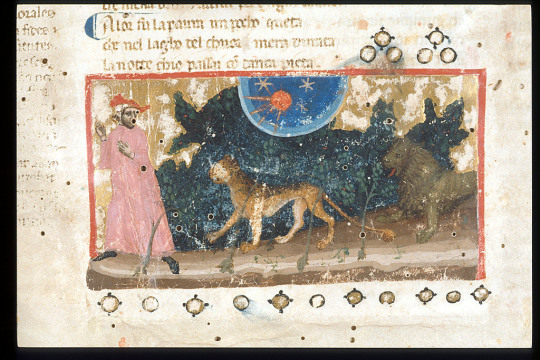
It’s easy to see then these animals as symbols of divine judgement on Dante. Dante is not ready to find the divine light. He is still under judgement. His sins have not been dealt with and as we shall learn, only by descending to hell and rising through the mountain of purgatory will he be able to find that light as a 'saved' soul.
All three wild beasts are mentioned in the bible and used as symbols of the kind of fate that will befall the people of God as divine judgment.
In Hosea 13:4-8 God says that he will be like a lion and a leopard (and an angry mother bear!) towards his ungrateful, apostate people.
In Jeremiah 5.1-6, Jeremiah fails to find one godly (just) person in the city of Jerusalem. Failing to do so God promises that judgement will come like this:
Therefore a lion from the forest will attack them, a wolf from the desert will ravage them, a leopard will lie in wait near their towns to tear to pieces any who venture out, for their rebellion is great and their backslidings many. (NIV)
If indeed the wild beasts represent the judgement of God in the Old Testament through Hosea and Jeremiah, in the New Testament they take another form entirely. And this may well have played a part in Dante’s thought. It is entirely possible that Dante is thinking of the Apostle Paul's reference to 'fighting wild beasts in Ephesus' (1 Corinthians 15.32). Of course Paul didn't mean he actually wrestled lions and wild beasts. He meant that dealing with those who opposed him there was just like being a gladiator in the arena fighting lions and bears. And the people who opposed him were the institutions of Ephesus, the city authorities, the trade guilds, the business leaders.
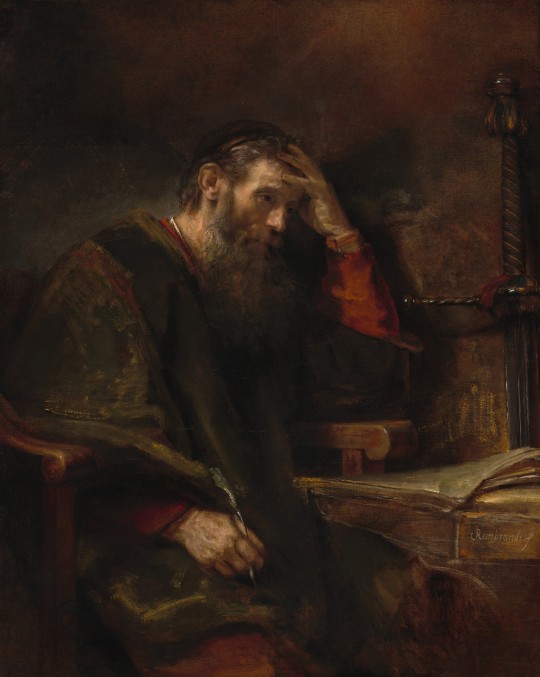
Dante the pilgrim, following in the footsteps of the Apostle struggles with his own 'wild beasts'. the wild beasts who had plotted against him, and exiled him from his native city in 1302. Dante the pilgrim walks in the footsteps of Paul. He also walks in the footsteps of Christ who was alone in the wilderness with the wild beasts for 40 days and 40 nights. Although the the original intention of the gospel writers may have been to conjure up the impression of a restored Eden, for Dante those accounts would have conjured up the idea of conflict and danger.
Like Paul and like Christ, Dante the pilgrim has to struggle with ferocious animals in his journey towards God, just as Dante the writer has had to in his journey.
Who or what then are these forces, these wild animals who prevented Dante from finding the true path? Interestingly these animals were all prized in one way or another in Dante's native Florence.
There is evidence that a leopard and a number of lions were kept and publicly displayed in cages in Florence in Dante's day near what is today the Loggia del Bigallo, as a sign of Florence's power and prestige.
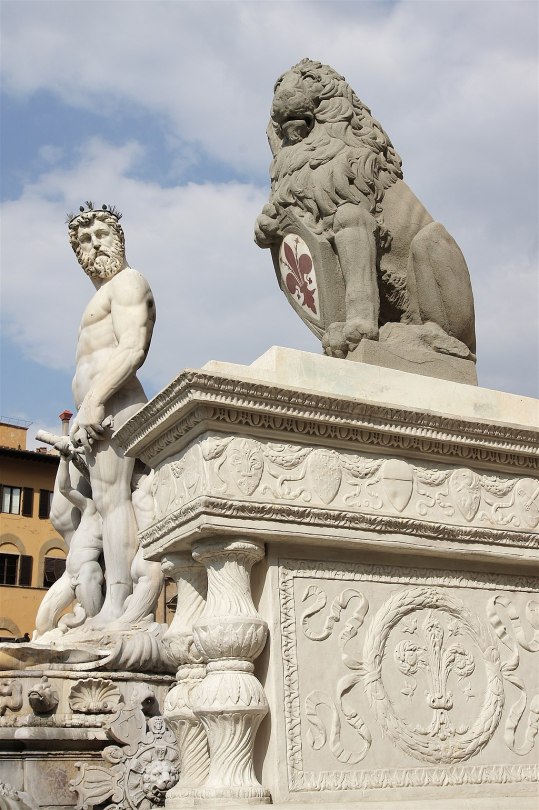
The lion was also part of Florence's coat of arms. Scholars have noted that Dante was familiar with the writings of Richard of St Victor who had associated the leopard with the sins of deceit and fraud. The lion was associated in medieval bestiaries with the sin of avarice (because of its apparently insatiable hunger) as well as with pride. These are 'civic sins' as much as personal vices.
Was it Florence's avarice and pride that was in the front of Dante the writer's mind when he described the leopard's gaudy spots and the lion with its head held high? Is it perhaps the city that had turned against Dante and thrown him out to live a life of exile that prevents the progress of the pilgrim towards paradise?
The she-wolf is the most daunting beast of all. She proceeds terrifyingly, step by step stalking forward, threatening and relentless. Dante comments:
The very sight of her so weighted me with fearfulness that I abandoned hope of ever climbing up that mountain slope. . . . I retreated down to lower ground.
Surprisingly perhaps it is the she-wolf, not the leopard or the lion that finally causes the pilgrim to despair. Wolves were considered to be symbols of fraud and deceit as well as sexual immorality and prostitution.

In his hugely influential work The City of God, St Augustine had commented that in his time prostitutes were known as she-wolves and a brothel was known as a 'wolf den'. He suggested that this verbal link gave rise to the famous origin myth of Rome, according to which the two twins Romulus and Remus, the offspring of the god Mars and the their mother (whom he had raped) Rhea, were abandoned to die but were saved and suckled by a she-wolf. Augustine suggests that instead, they were found and fed by an unknown prostitute i.e. by a 'she-wolf'. From this play on words came the legend that it was a literal she wold who found and fed them. In the City of God (Book 18 chapter 21) Augustine writes as follows:
“Procas ruled before Aemulius. Now Aemulius had made his brother Numitor's daughter, named Rhea, a Vestal Virgin; she was also called Ilia, and was the mother of Romulus. The Romans wish to say that she conceived twins by Mars; for, in this way, they honoured, or excused, her unchastity. They offer as proof of this the legend that, after their exposure, the infants were suckled by a she-wolf. For they hold that this species of animal belongs to Mars; and so, therefore, the she-wolf is believed to have offered her teats to the little children because she recognised in them the sons of Mars, her master.
There is, however, no lack of people who say that, when the exposed infants lay wailing, they were first taken in by some unknown whore, and that hers were the first breasts they sucked - for ‘she wolves’ (lupae) was the name given to whores, which is why houses of ill repute are even now called ‘wolfouses’ (ilupanaria). Afterwards, it is said, they came into the care of a shepherd called Faustulus, and were nurtured by his wife Acca. And yet if, in order to convict the man who was king, and who had cruelly commanded that these infants be cast into the water, God willed to help the children through whom such a great city was to be founded, and to have them rescued from the water by His divine intervention and suckled by a wild animal: is there anything very wonderful in this? “
- Translated by W. Dyson (Cambridge Texts in the History of Political Thought)
So, according to Augustine, it wouldn't be surprising if God had supplied a real she-wolf to find and feed the abandoned babies, because God is merciful and just, but in fact the stories he has heard suggest a different explanation. Namely that it was a human 'she-wolf', a whore, who had found them.
It is also interesting that Augustine links the god Mars with the story. The wolf, he says, is one of Mars' own creatures' i.e. a beast with a special affinity to Mars. Is it relevant that the city of Florence had adopted Mars as its own patron 'star'? It may also be relevant that the name of the Guelf faction, some of whom had ordered Dante's expulsion from Florence, was linked to the German word for wolf (Welf). Dante's enemies in Florence were 'wolves'. It seems the clue lay in the name.
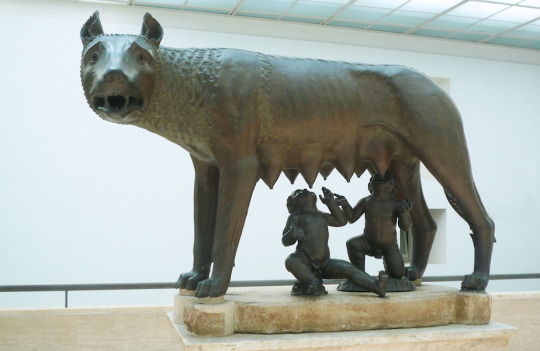
But it may not have been only Florence Dante wanted to suggest to readers' minds. In addition it seems that by the time Dante wrote the Divine Comedy the Papal Curia had adopted as its own symbol the famous statue of Romulus and Remus suckling from the mother she-wolf on the Capitoline Hill. The she-wolf was of course the defining myth of Rome’s founding. Several ancient sources refer to statues depicting the wolf suckling the twins. Livy reports in his Roman history that a statue was erected at the foot of the Palatine Hill in 295 BC. Pliny the Elder mentions the presence in the Roman Forum of a statue of a she-wolf that was "a miracle proclaimed in bronze nearby, as though she had crossed the Comitium while Attus Navius was taking the omens". Cicero also mentions a statue of the she-wolf as one of a number of sacred objects on the Capitoline that had been inauspiciously struck by lightning in 65 BC: "it was a gilt statue on the Capitol of baby being given suck from the udders of a wolf." Cicero also mentions the wolf in De Divinatione 1.20 and 2.47.
The Capitoline Wolf was widely assumed to be the very sculpture described by Cicero, due to the presence of damage to the sculpture's paw, which was believed to correspond to the lightning strike of 65 BC. The 18th-century German art historian Johann Joachim Winckelmann attributed the statue to an Etruscan maker in the fifth century BC, based on how the wolf's fur was depicted. It was first attributed to the Veiian artist Vulca, who decorated the Temple of Jupiter Capitolinus, and then reattributed to an unknown Etruscan artist of around 480 - 470 BC.
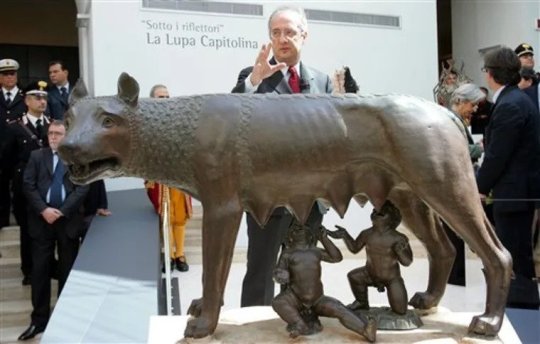
So for centuries The Capitoline Wolf was almost universally recognised as an Etruscan statue from the early part of the 5th century BC. It was only in 2006 that an Italian art historian and restorer, Anna Maria Carruba, published a detailed critique against the accepted view. She argued that the bronze had been cast with a method unknown in classical times, and that marks left by the artist on its surface were more typical of the Middle Ages. Barely a year later in 2007, Rome’s top archaeologist and heritage advisor, Prof. Adriano La Regina, reported that over 20 tests using radiocarbon and thermoluminescence dating don at the University of Salerno suggested that the wolf portion of the statue may have been cast between 1021 and 1153. Overnight one ancient Rome’s oldest artefacts became one of city’s youngest.
Given the pride and place of this famous statue, The Capitoline Wolf, given by the Church of Dante’s time, it adds an extra dimension to any reading Dante’s words about the she-wolf. For the wolf, the creature of Mars, the symbol of Rome and now of the church was a big thing in 13th century Italy. It is this beast that scares Dante the most, that strips away his hope and forces him to turn around. It is this beast he says which has been ‘the despair of many’. It is not a surprise then to find that throughout the Inferno he likens various damned souls to wolves.
Again the bible may have played a part in his thinking Jesus warned his disciples to watch out for the false prophets, the wolves who come dressed in sheep's clothing. Ithink it’s too much of a stretch to say it was a direct attack on the church or the papacy of Boniface VIII but it does lend credence to the possibilities of personal corruption for those in the church who flirted with earthly temptations and sins - the very sins that destroyed souls and blocked humanity’s upward path to heavenly salvation.
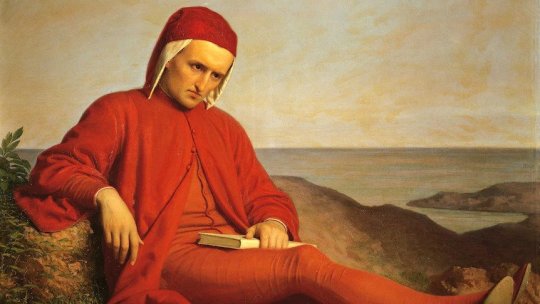
For Dante there was no distinction between the inner and the outer person or between the individual and social. The individual did not live a life apart from his or her wider life in the state and in the church. Sin was something that affected everything and everyone. These beasts may well represent sin or vices with which Dante the writer was only too familiar in his own experience but to me it seems highly likely that they represent above all the forces he saw around him which, in his mínd, prevented people finding the beauty and love of God. The Apostle fought his wild beasts in Ephesus. Dante fought his in Florence.
The mythical figures featured in Dante’s Inferno lean on a long tradition of animals as allegory. As Dante journeys through the realms of the afterlife, these beings can lend a helping hand on the long and winding road through hell, purgatory, and heaven. While the creatures of the Inferno intend to scare sinners straight, they themselves also suffer as the embodiment of their respective sins.
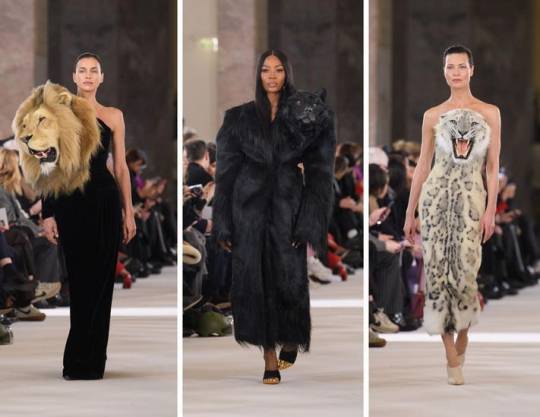
While hell is where sinners languish, it remains a complex and captivating place. Dante filled his entire Divine Comedy with bizarre creatures from across literature, and they serve a similar purpose to any beast in a story: to distill morals or a lesson. Their presence makes the story memorable, even for modern readers like us today.
Dante’s Inferno brings readers on a journey through hell, replete with allegories from across time like sitting through a hellscape of a Schiaparelli haute couture fashion show during Paris Fashion Week. As time wears on, Inferno’s wild beasts offer captivating perspectives on our very modern sins of lust for affirmation, pride in our self-centredness, and an avarice for material comfort.

But I don’t wish to end on a downer because Dante is not a pessimistic poet. Most readers never proceed beyond the macabre thrills of Dante’s ‘Inferno’, with its grotesquely inventive torments. Those who do ascend from the “Inferno” find some of Dante’s most lyrical verse in his ‘Purgatorio’. But it is the least-read of the three books, ‘Paradiso’, that makes sense of the other two. It shows, Dante was not just a poet of crisis, but also a poet of hope:
The ‘Divine Comedy’ is that rarest thing, an epic poem with a hopeful ending. It is about getting a second chance - and ultimately finding joy, a Christian understanding of joy in the light of God’s saving grace.
#essay#dante#dante alighieri#divine comedy#commedia#italian#poem#epic#literature#christian#christianity#church#bible#history#schiaparelli#paris fashion week#paris#paris fashion week 2023#shalom harlow#naomi campbell#irina shayk#supermodels#daniel roseberry#sin#fashio#clothes#haute couture#lion#leopard#she wolf
91 notes
·
View notes
Photo
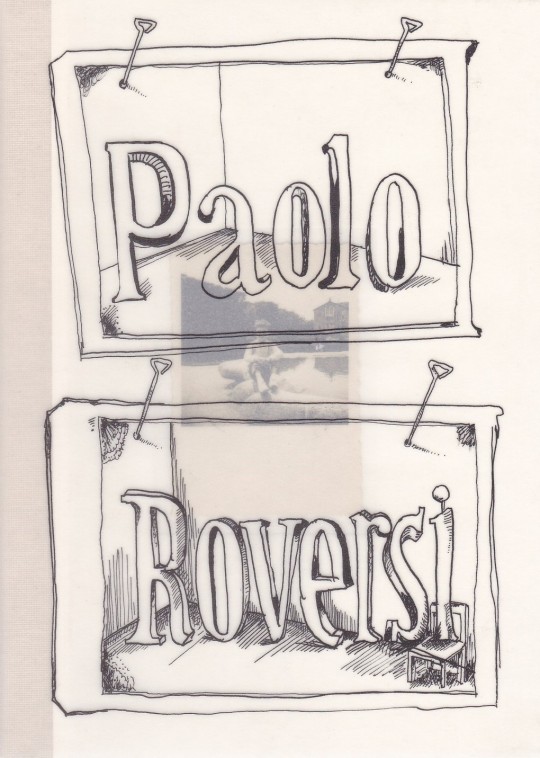

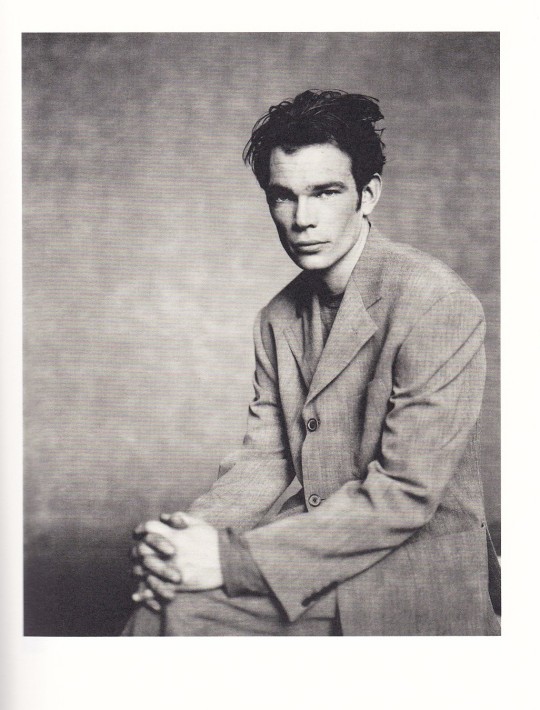

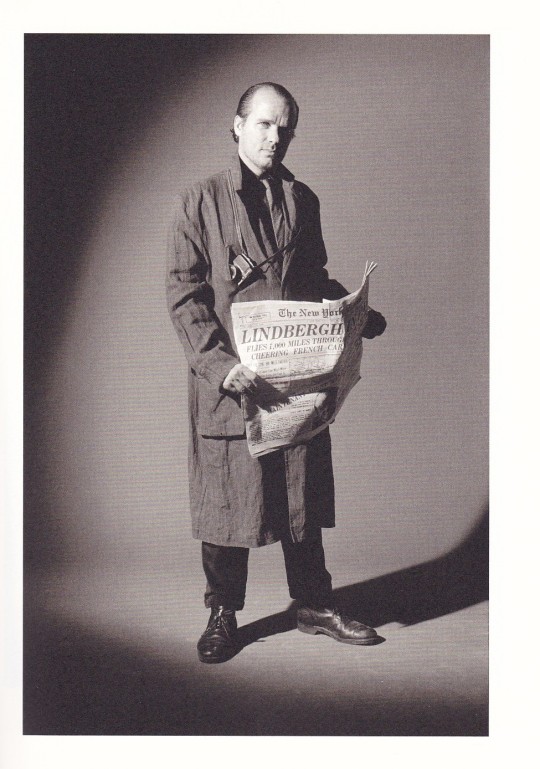
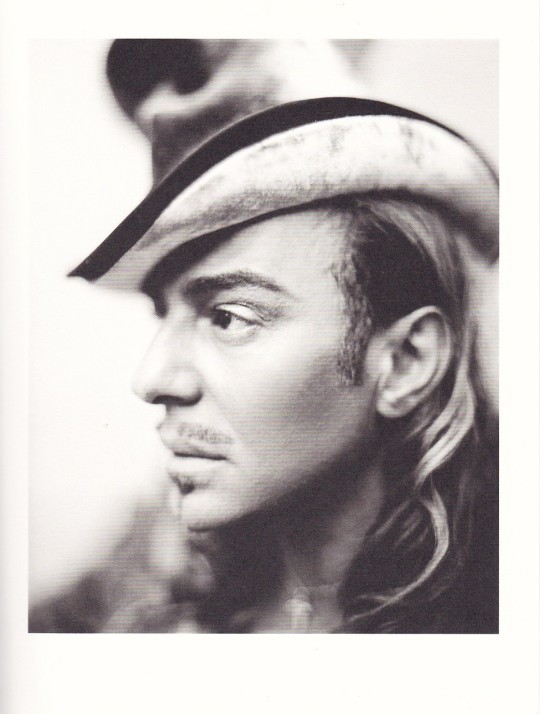
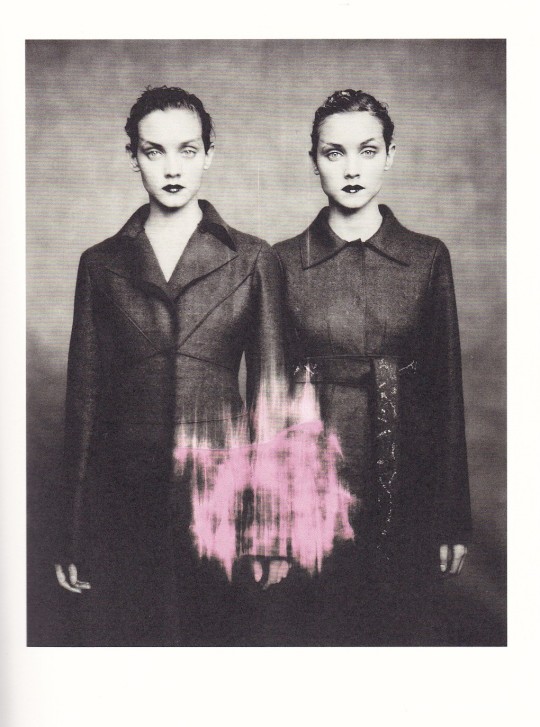


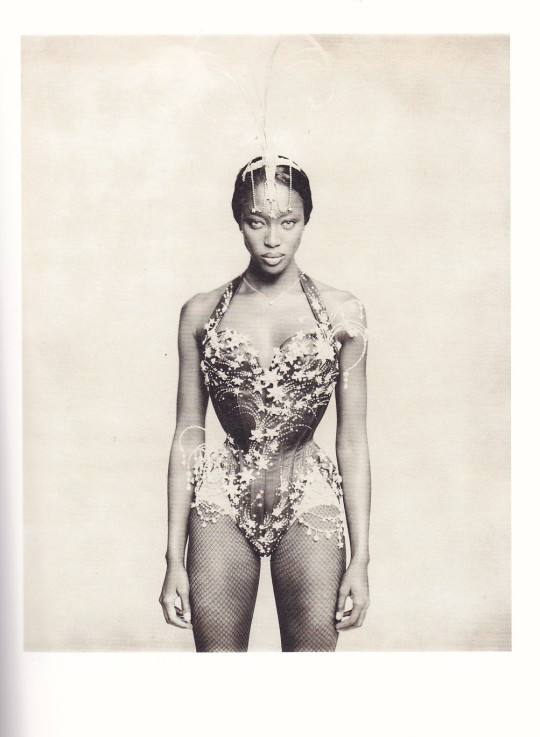
Paolo Roversi - Studio Luce
texts Paolo Roversi, Chiara Bardelli Nonino and Emanuele Coccia
Books designed at M/M (Paris)
Cover Art by Mathias Augustyniak
Editions Stromboli, Paris 2020, 420 pages, 18 x 24 cm., First edition of 1200 copies, ISBN 978-2-9546506-3-0
euro 580,00
email if you want to buy [email protected]
Museo d’Arte della città di Ravenna October 11, 2020 - January 10, 2021 Exhibition curated by Chiara Bardelli Nonino
Paolo Roversi – Studio Luce is a unique opportunity to get to know the work of the great photographer Paolo Roversi. Paolo Roversi was born in Ravenna in 1947. In 1973 he moved to Paris, where he still lives and works in his studio in Rue Paul Fort – the very same Studio Luce the exhibition/book is named after.
The photographs contain numerous references to his hometown, Ravenna, the place that more than any other has shaped his imagination. His first fashion photographs and a series of portraits of friends and artists, are alternated with still lifes of stools collected in the street or those of Paolo’s long-trusted Deardorff camera. Among his most recent works, some shots for the Pirelli 2020 Calendar, as well as a series of previously unreleased fashion shots from his decades of work for brands such as DIOR and Comme des Garçons and for magazines such as Vogue Italia.
As a tribute to the seven-hundredth anniversary of Dante Alighieri’s death, there’s a vast selection of shots directly from Roversi’s archive that celebrate and reinvent the figure of the muse – as an ideal reference to Dante’s Beatrice from the Divina Commedia – interpreted here in a contemporary way by iconic women such as Natalia Vodianova, Kate Moss, Naomi Campbell and Rihanna.
06/10/22
orders to: [email protected]
ordini a: [email protected]
twitter: @fashionbooksmi
instagram: fashionbooksmilano, designbooksmilano tumblr: fashionbooksmilano, designbooksmilano
#Paolo Roversi#Studio Luce#rare books#M/M (Paris)#Editions Stromboli#photography exhibition catalogue#Museo Arte città Ravenna 2020-21#Kate Moss#Rihanna#Naomi Campbell#Comme des Garçons#Dior#Romeo Gigli#Peter Lindbergh#photography books#fashion photography#fashion books#fashionbooksmilano
35 notes
·
View notes
Text
List of Tributes
Satan (The Bible)
Satan (Dante's Inferno)
God (New Testament)
God (Old Testament)
Judas Iscariot
Jesus (The Bible)
Virgin Mary
Jesus (JoJo's Bizarre Adventure)
Santa Claus
Larry the Cucumber (VeggieTales)
Saint Patrick
The Garden of Eden snake
Various Donkeys
The Wise Men's camels
Two penguins from Noah's Ark
Noah
The whale that ate Jonah
Jonah
The lion that didn't eat Daniel
Samson
The 2 bears Elisha summoned
War (of the Four Horsemen)
The fig tree Jesus yelled at
Saint Mary Mackillop
Saint Guinefort
The Golden Calf
The King James Bible
Psalty the Singing Songbook
30 Silver Pieces
The Good Samaritan
Religious Trauma
The Cross
Dante Alighieri
Screwtape
Moroni
Judge Deborah
Enoch
Joseph ben Caiaphas
Pontius Pilate
Barabbas
The Burning Bush
Moses
Pope Stephen VI
Martin Luther
The woman okay with killing the baby (Solomon's Judgement)
The baby (Solomon's Judgement)
King Solomon
Herod the Great
Mary Magdalene
Mary of Bethany
Jesús Cristo (Clone High)
Our Lady of Guadalupe
Elijah
John the Baptist
Yael (also called Jael)
Joan of Arc
Saint Margaret of Antioch
Michelangelo's David
Leviathan
Behemoth
Slut!Michael
Lilith
Azrael
Gabriel
13 notes
·
View notes
Photo

Beata Beatrix, Dante Gabriel Rossetti, 1871, Art Institute of Chicago: European Painting and Sculpture
Both a poet and a painter, Dante Gabriel Rossetti was a founder of the Pre-Raphaelite Brotherhood, a circle of Victorian artists who were united in their regard for medieval aesthetics. Named after the thirteenth-century poet Dante Alighieri, Rossetti found inspiration for Beata Beatrix in his namesake’s La vita nuova (The New Life; 1295). Rossetti’s scene draws a parallel between Dante’s love for the late Beatrice and his own affection for his recently deceased wife and muse, Elizabeth Siddal. While this picture is a tribute to Siddal, Rossetti was adamant that it does not represent her death. Rather, the work portrays her as if in a trance or altered spiritual state. Rossetti’s symbolism combines details from his personal life with those from La Vita Nuova. “The Dove” was the artist’s nickname for Siddal, and a haloed dove delivers her a white poppy, a symbol of laudanum—a derivative of opium—which caused her death by overdose. Above rises the Ponte Vecchio, the Florentine bridge that served as the setting of Dante’s poem. To the upper left is the personification of Love and to the right the figure of Dante, who doubles as a representation of Rossetti himself. The sundial shadows the number nine, the age Dante first saw Beatrice as well as the hour and day of her death. Rossetti designed the frame, and at the top right he inscribed, “How doth the city sit solitary.�� This quote from La Vita Nuova refers to the city of Florence’s mourning of Beatrice. Given the deeply personal nature of the work, Rossetti initially refused his patron William Graham’s request to create a replica, although he eventually yielded. The Art Institute’s painting is this second version, which is the only one to have a predella—the painted scene at the bottom of the frame—depicting Beatrice and Dante’s reunion in paradise. With this addition, Rossetti provides the medieval love story with a happy conclusion, perhaps suggesting that he, too, had begun to come to terms with his own profound grief. Charles L. Hutchinson Collection Size: 87.5 × 69.3 cm (34 7/16 × 27 1/4 in.) Predella: 26.5 × 69.2 cm Medium: Oil on canvas
https://www.artic.edu/artworks/16551/
31 notes
·
View notes
Text
30 (Technically 34) Albums We Loved That Happened To Come Out in 2020
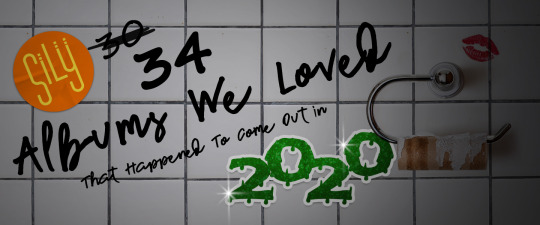
So much has already been said and written about this cursed past year, but a few good things came out of it, including the music. Album-wise, like many before it and many to come, it was an embarrassment of riches. But even with so much time on our hands to devour new tunes, it was often old favorites, songs of comfort or familiarity that garnered the heaviest rotation. For many artists, too, it was a year ripe for revisiting or reissues of old material, looking at existing songs with fresh and new perspectives. Simply put, with so much to listen to, new and old, the prospect of ranking a finite number of albums felt not only daunting, but frankly a bit stupid. Maybe we were late to the game, but 2020 taught us that music should and can be appreciated in multiple contexts, not limited to but including when it first came out and when it was heard again and again, even if years later. The records below--listed in alphabetical order--happened to be released in some form in 2020, whether never-before-heard or heard before but in a different format. And the only thing I know is that we’ll be listening to them in 2021 and beyond.
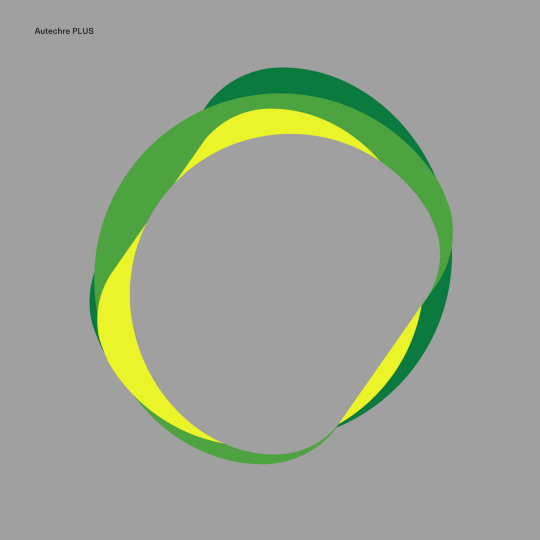
Autechre - SIGN & PLUS (Warp)
The legendary British electronic music duo surprise released SIGN a mere month and a half after its announcement and then PLUS 12 days later. The former was a beatific collection of soundscapes that belied the band’s usual harsh noise, while PLUS embraced that noise right back, drawing you in with the clattering chaotic burbles of opener “DekDre Scap B” and lurching forward. -Jordan Mainzer
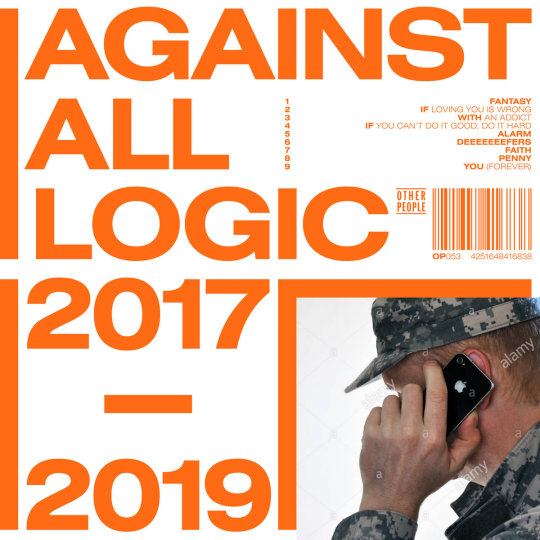
Against All Logic - 2017-2019 (Other People)
The perennially chill ambient house artist Nicolas Jaar had a busy 2020, as usual, releasing two albums under his name, Cenizas and Telas. But it was 2017-2019, the follow-up to the debut album from his Against All Logic moniker, that came first and throughout the year helped to illustrate Jaar’s penchant for combining inspired samples with club beats and tape hiss. Take the way the lovelorn vocals of “Fantasy” or soulful coos of “If Loving You Is Wrong” war skittering, scratchy percussion and cool arpeggios, respectively: Jaar is coming into his own as a masterful producer almost a decade after he released his first full-length. Oh, and bonus points for including none other than Lydia Lunch on a banger so blunt it would make Death Grips blush. - JM
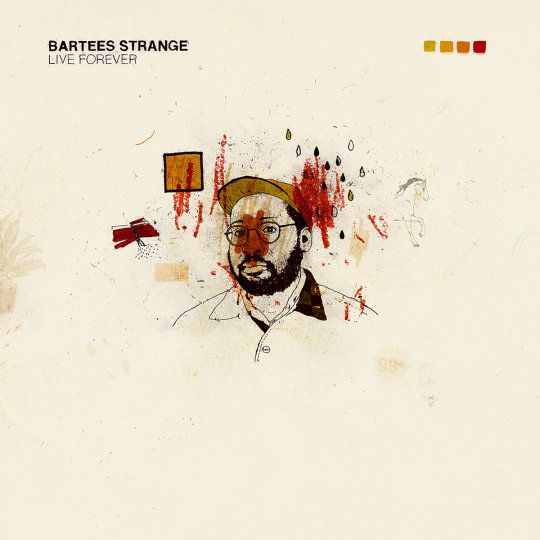
Bartees Strange - Live Forever (Memory Music)
Like many, my introduction to Bartees Strange was through Say Goodbye to Pretty Boy, his EP of The National covers. Creativity and shifting perspectives shine through each song’s reimaging, like flipping the coarse, almost manic “Mr. November” into something softer, more meditative. It felt like a mere peek into what was to come on Live Forever. Bartees Strange is a world-builder. Each track on his debut unfolds and welcomes you to a wildly engaging tableau, a fully constructed vision. “Jealousy” opens with soft vocals and birdsong. “In a Cab” is the slick soundtrack to racing through a cityscape in the rain, seeing the blurred lights of the high-rises above as you pass by. “Kelly Rowland” warps wistful pop song feelings. “Flagey God” takes you into a dark, pulsing club while only a few songs later, “Fallen For You” wraps you in echoed vocals and romantic, raw acoustic guitar.
It’s an accomplishment to craft an album of individual songs that stand strongly on their own but still feel cohesive. 2020 wasn’t all bad. It gave us Live Forever, a declaration of an artist’s arrival. - Lauren Lederman

Charli XCX - how i’m feeling now (Atlantic)
Back in the spring, many of us wondered who would put out something great in 2020’s quarantine. It was hard to imagine that the intensity of a global pandemic would really allow for artists to embrace creativity. That thought carries the same eye-roll inducing feeling of “We’ll get some great punk music out of a Trump presidency,” but of course, Charli XCX delivered. Through live workshops with fans and longstanding collaborators, she delivered songs to dance alone to in your bubble. Charli embraces the unknown of the moment but clutches onto what’s familiar. Under the glitch-pop veneer of the album, she digs into the anxieties of not just this moment of time but of the bigger questions we all confront: trajectories of relationships with friends, romantic partners, ourselves. Album standouts “forever” and “i finally understand” embrace that feeling of both looking for control and accepting the lack of it. Charli is a master at balancing this. - LL
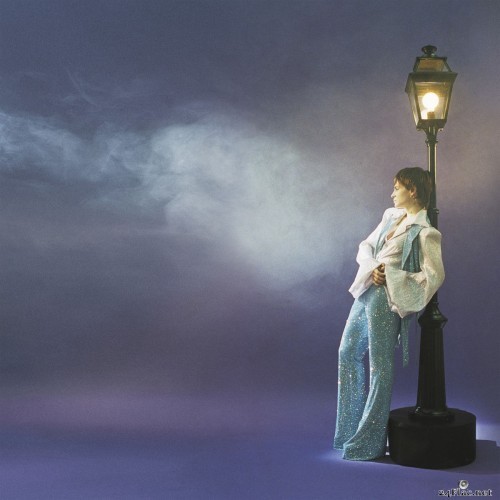
Christine and the Queens - La Vita Nuova (Because Music)
Named after a Latin text by Dante Alighieri about missing a woman who has died, Chris’ La Vita Nuova is not about mourning a death but instead about loneliness and isolation, post-relationship or otherwise. It doesn’t bang quite like her previous two albums, but it hits harder than ever.
Read our full review here.
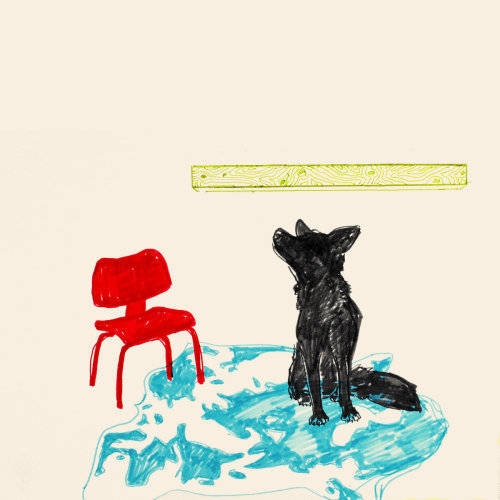
Dogleg - Melee (Triple Crown)
Released on March 13th, right as the COVID-19 pandemic hit, Melee was supposed to be supported by three cancelled tours–SXSW, an opening slot for Microwave, and an opening slot for Joyce Manor–and an appearance at this year’s cancelled Pitchfork Music Festival. Listening to the songs on the record, you can only imagine how they translate: the jerky momentum of “Bueno”, build-up of “Prom Hell”, gang vocals of “Fox”, clear-vocal anthem of “Wrist”, and odd groove of “Ender”.
Read “Buckle Up, Motherfucker”, our interview with Dogleg.
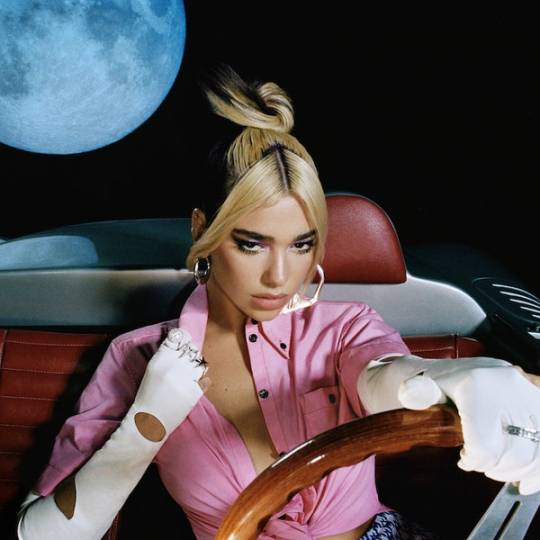
Dua Lipa - Future Nostalgia & Dua Lipa/The Blessed Madonna: Club Future Nostalgia (Warner)
Where Dua Lipa’s much-anticipated second album Future Nostalgia succeeded was in its disco anthems and retro, club-ready beats, so who better to bring out the best of the record than The Blessed Madonna? The turntablist masterfully curates a mix of heavy hitters of the charts and the underground that not only offers an essential complement to Future Nostalgia but transcends it. Sending the tracks out to various producers and singers for features and then adding her own samples on top, she invites you to peel back the layers, enter a YouTube rabbit hole of sample searching as much as bopping along.
Read our full review here.
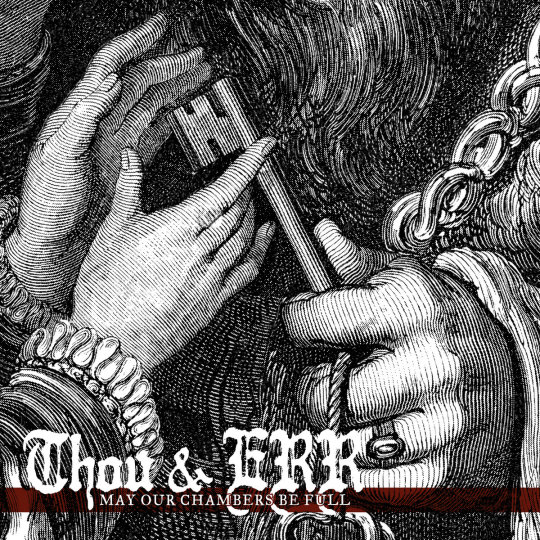
Emma Ruth Rundle & Thou - May Our Chambers Be Full (Sacred Bones)
Roadburn Festival has long been on my bucket list, and since the pandemic showed me how much live music can be taken away in a flash, when it’s safe again to travel and go to a festival, I may just pull the trigger and go--especially considering it’s the springboard for such fruitful and inspired collaborations as the one between Louisville singer-songwriter Emma Ruth Rundle and Baton Rouge sludge dwellers Thou. Rundle embraces the heavier opportunities on the follow-up to her incredible 2018 record On Dark Horses with the ever-flexible Thou backing her up vocally and instrumentally. Slow-burning opener “Killing Floor” offers a familiar introduction to fans of both--sort of what a Rundle/Thou song would sound like--before grunge chugger “Monolith” introduces huge, catchy riffs and “Out of Existence” a True Widow-esque dirge, newfound inspirations for both artists bringing the best out of each other. - JM
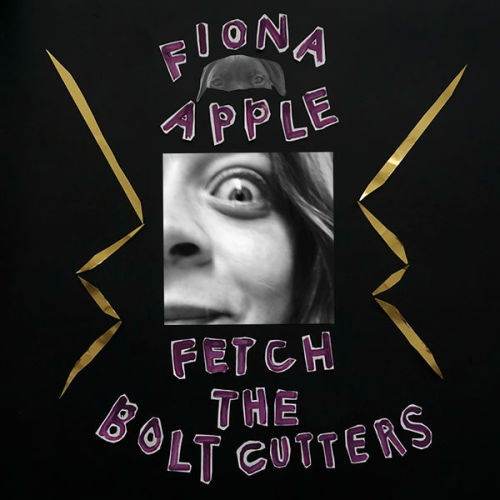
Fiona Apple - Fetch the Bolt Cutters (Epic)
What makes Fetch the Bolt Cutters stand out among Apple’s catalog and music in general is the clarity with which Apple seethes at those who have wronged her, whether ex-boyfriends or patriarchal oppressors, and looks to her relationships with other women for peace of mind.
Read our full review here.
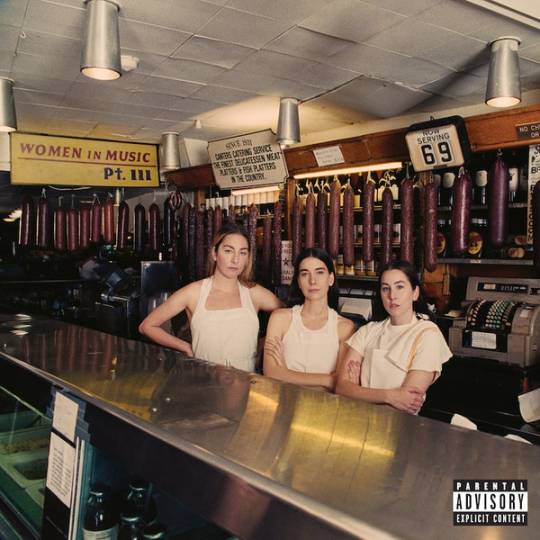
HAIM - Women in Music Pt. III (Columbia)
For HAIM, the title Women in Music Pt. III is suggestive that, more than their previous two records, their third centers around the experiences of being an all-female band in a historically white cis male-dominated scene, at least one that wouldn’t call catchy riffs written by a man “simple” or call attention to the faces a man makes while playing. What it doesn’t let on to is how deeply personal the record is, how, by unabashedly embracing genres and styles of music that they love, HAIM have made far and away their best album. Co-produced by the usual suspects, Danielle Haim, Ariel Rechtshaid, and ex-Vampire Weekender Rostam Batmanglij, it’s instrumentally and aesthetically dynamic and diverse, consistently earnest without devolving into cheese.
Read our full review here.
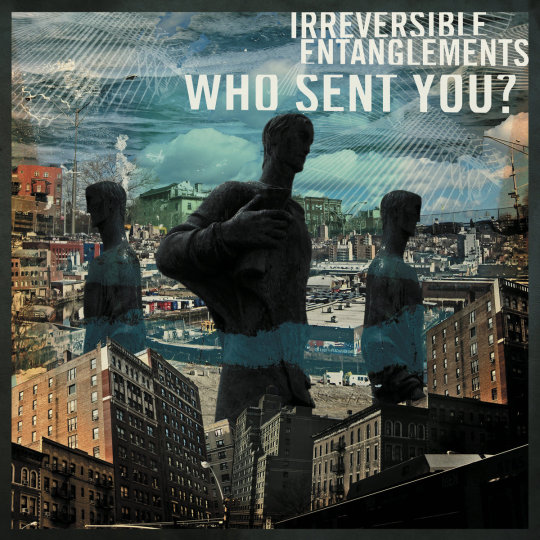
Irreversible Entanglements - Who Sent You? (International Anthem)
I’ve been captivated by Irreversible Entanglements ever since I first saw them at Pitchfork Music Festival 2018. The radical poetry of Camae Ayewa (aka Moor Mother) is the perfect front for a ramshackle mix of Luke Stewart’s spidery bass, Tcheser Holmes’ weighty drums, and a horn section that concocts tones that range from hopeful to desperate. At their best, Who Sent You? is a shining example of celebratory Afrofuturism and metaphysics that makes the urgency of Ayewa’s more concrete and political words all the more necessary. “No Más”, composed by Panamanian-born trumpeter Aquiles Navarro, is a declaration against imperialist oppression, while the stunning title track flips the switch like a Kara Walker painting, as Ayewa’s the one interrogating the police officer terrorizing her community. “Who sent you?” she repeats, never spiraling, grabbing a hold of the power and never letting go. - JM
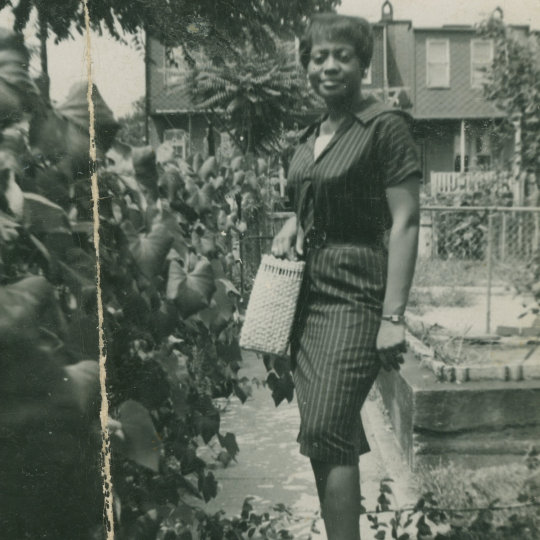
Jeff Parker - Suite for Max Brown (International Anthem/Nonesuch)
It’s Jeff Parker’s mom’s turn. After 2016′s The New Breed ended up being a tribute to the guitarist’s father, who passed away during the making of it, Parker decided to pay tribute to Maxine while she was still alive. Suite for Max Brown (Brown is his mother’s maiden name; Max is what people call her) is a genre-bending collection of tracks inspired by Parker’s DJing, juxtapositions of sequenced beats with improvisation that certainly sound like the brainchild of one individual. Indeed, Parker plays the majority of the instruments on it and engineered most of it at home or during his 2018 Headlands Center residency in Sausalito, CA; though all of the players and the vocalist (Jeff’s daughter Ruby Parker) on The New Breed show up, plus a couple trumpeters (piccolo player Rob Mazurek and Nate Walcott of Bright Eyes) and cellist Katinka Kleijn, Suite for Max Brown is a distinctly Jeff Parker record.
Read our preview of Jeff Parker & The New Breed’s set at Dorian’s last year.

Jeff Rosenstock - NO DREAM (Polyvinyl)
Jeff Rosenstock throws us right into the spinning, manic energy of NO DREAM, his latest release from a seemingly endless well of music that never lacks urgency. It’s a reminder that though it’s been a strange year, the issues Rosenstock tackles here aren’t new. There’s no interest in making you feel comfortable here. On the album’s title track, Rosenstock sings, lulling you into a false sense of security, “They were separating families carelessly / Under the guise of protecting you and me.” But reality sets in, and the hazy guitars spin out as he spits, “It’s not a dream!” and, “Fuck violence!”
My image of Jeff Rosenstock in the year 2020 is masked up with “Black Lives Matter” scrawled across the fabric of his mask in Sharpie, performing album highlight “Scram!” on Late Night with Seth Meyers as high energy as ever. It felt like watching someone send out a beacon, both a distress signal and a call to arms. - LL
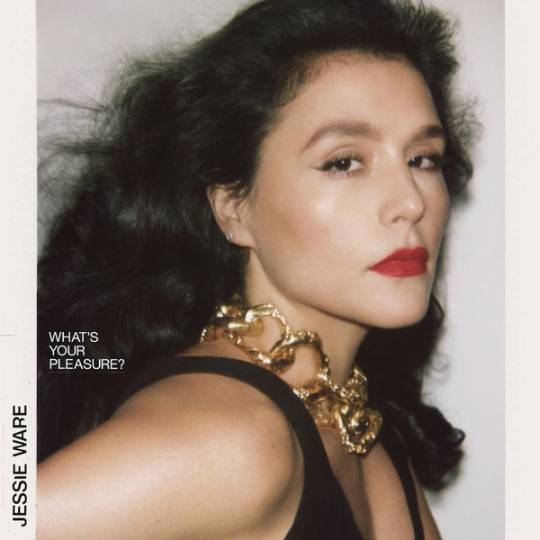
Jessie Ware - What’s Your Pleasure? (PMR/Friends Keep Secrets/Interscope)
I am not someone who goes to clubs. I don’t “go out dancing,” preferring to let loose in the privacy of my own home or a trusted friend’s house party. But Jessie Ware’s What’s Your Pleasure? makes me think I could embrace a night out like that, once the world opens up again, of course. The album is filled with syncopated disco beats that feel fresh and classic all at once. The abundant horns and strings on “Step Into My Life” are decadent, like light bouncing off sequins in a dark room. Ware’s voice is slinky and velvety one moment, windswept like her album cover the next. It’s songs like “Save a Kiss” that embrace both, allowing her to show off her range. - LL
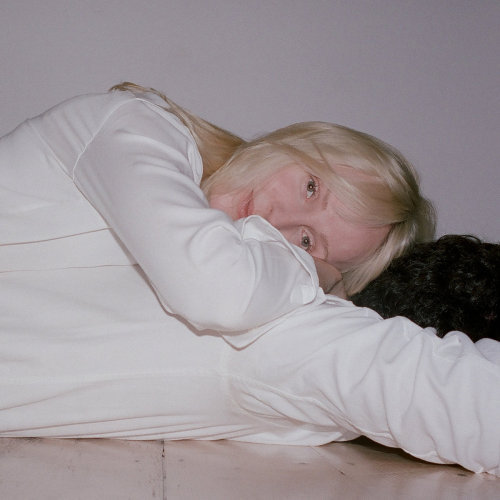
Laura Marling - Song for Our Daughter (Partisan)
With sparse production, mostly from her but with additions from Ethan Johns and Dom Monks, Marling foregoes the comparative maximalism of the Blake Mills-produced Semper Femina, her last proper full-length, and 2018′s LUMP collaboration. The songs aren’t simple, but they’re succinct, and every element, from Marling’s finger-picked guitars, the occasional slide guitar, and that unmistakably calm voice, sometimes alone and sometimes layered, fits. It’s her most universal set of songs yet, centering around the times when we’re apart from one another but reflecting on when we were together and when we might be together again, with no guarantees.
Read the rest of our review here.
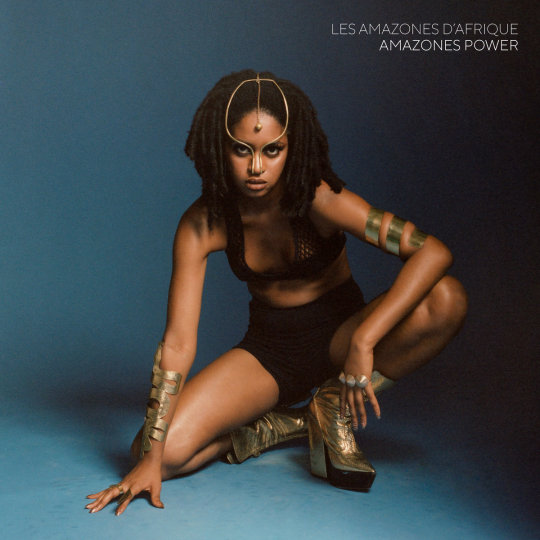
Les Amazones d’Afrique - Amazones Power (Real World Records)
The groovy pan-African collective expands upon their debut Republique Amazone and then some with Amazones Power, a tour-de-force statement of female empowerment in the face of oppression against women throughout the African diaspora. Indeed, the album is more than just songs boldly decrying FGM, though those demands ring heavily. Instead, the group goes further, delving into gender power structures in marriage on “Queens” and selectively finding strength in tradition on “Dreams”. And this time, they include men to stand alongside with them. “Together we must stand / Together we must end this,” sings Guinean musician/dancer/artist Niariu on opener “Heavy” in solidarity with features Douranne (Boy) Fall and Magueye Diouk (Jon Grace) of Paris band Nyoko Bokbae. But perhaps it’s her kiss-off on “Smile” that hits hardest: “I shut up for no one.” - JM

Lianne La Havas - Lianne La Havas (Nonesuch)
The British singer-songwriter’s much anticipated follow-up to 2015′s Blood was better than I could have ever imagined. A song cycle about life cycles--of nature, of lives, of a relationship--inspired by an actual breakup, Lianne La Havas is a contemporary neo soul masterpiece. Overview opener “Bittersweet” is an instant earworm, La Havas’ coo-turned-belt filling the space between classic and increasingly emotive slabs of piano and guitar. Funky, lovestruck strut “Read My Mind” is the soundtrack for the unbridled confidence of finding new love. Yes, the doubts begin to sow on the fingerpicked melancholy of “Green Papaya” and “Can’t Fight”, and where the album goes from a simple narrative perspective may be predictable: They break up, they don’t get back together, La Havas enjoys her independence. But the depth of the arrangements and assuredness of La Havas’ singing is a product of an artist starting to really show us what she can do. And how many people can pull off a Radiohead cover like that? - JM
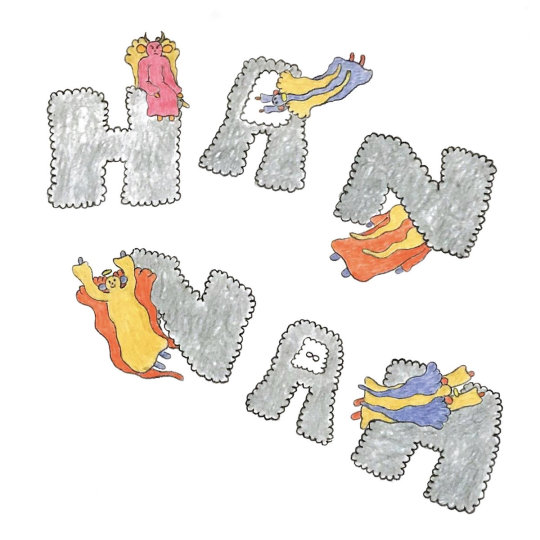
Lomelda - Hannah (Double Double Whammy)
What does it mean to title an album after yourself? Lomelda’s latest album is centered around discovering more about yourself while not always having the answers. Despite the lyrical content, the album is self-assured. Hannah Read’s voice feels as steady as ever as it navigates these twisting questions, like the way the world can shift after a kiss. She finds power in softness and reflection throughout the album, like when she explores the mantra-like words of “Wonder” or through a reminder to do no harm in “Hannah Sun”. In a year that allowed for perhaps more reflection than usual, Hannah makes space for the questions that arise out of figuring yourself out, of making sense of the messiness of it all, wrapped in warm guitar, balanced vocals, and steady drums. - LL
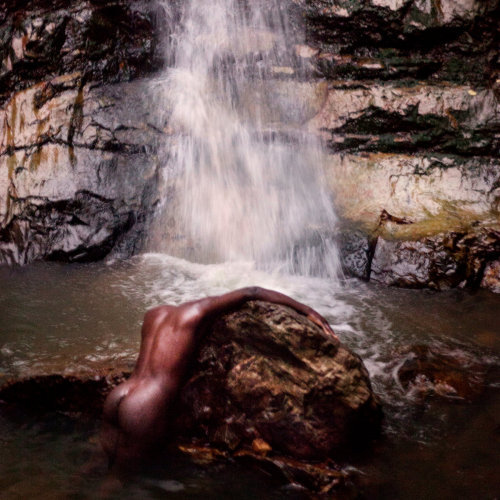
Moses Sumney - Grae (Jagjaguwar)
“Am I vital / If my heart is idle? / Am I doomed?” Moses Sumney famously sang on his stunning 2017 debut Aromanticism, an album that saw him developing his acceptance of being alone. grae, his two-part 2nd full-length, and his first since officially moving from L.A. to the Appalachian Mountains of Asheville, North Carolina, doubles down on themes of heartbreak, but instead of being sure in his seclusion, he embraces the unknown. The album teeters between interludes of platitudes about isolation and ruminations on failed human connection, and maximally arranged clutches of uncertainty. “When my mind’s clouded and filled with doubt / That’s when I feel the most alive,” Sumney coos over horns and piano on slinky soul song “Cut Me”; it’s an effective mantra for the album.
Read the rest of our review here.

Norah Jones - Pick Me Up Off The Floor (Blue Note)
At the time we previewed Norah Jones’ 7th studio album, she had only released a few tracks from it. Turns out the rest was just as powerful. From the blues stomp of “Flame Twin” to the rolling piano stylings of “Hurts to Be Alone”, Pick Me Up Off The Floor is an album full of jazzy orchestrations and soul and gospel-indebted arrangements, Jones’ silky, yearning voice tying together the simple, yet lush and deep instrumentation. And that other Tweedy feature, that closes the album? It’s a heartbreaking portrait of loneliness, one of many on a record that still manages to celebrate being alive all the while. - JM
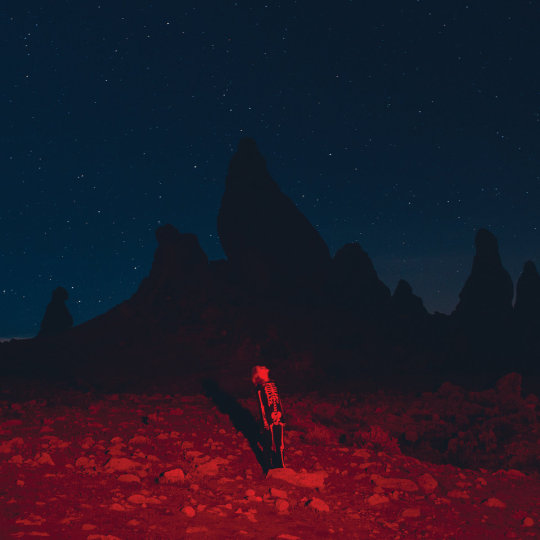
Phoebe Bridgers - Punisher (Dead Oceans)
Phoebe Bridgers is a master of details. Her lyrics shine when they get specific. They range from the mundane to morbid: A superfan’s ghost-like wandering under a drugstore’s fluorescent lights, a skinhead likely buried under a blooming garden, reckoning with the you in “Moon Song”’s lines, “You are sick, and you’re married / And you might be dying.” Bridgers has always been able to set a scene meticulously, and Punisher arrived with 11 songs that expanded that skill, both lyrically and musically, with her dark humor intact and a fuller sound that includes her boygenuis collaborators’ harmonies. - LL

PJ Harvey - To Bring You My Love: The Demos & Dry - The Demos (Island)
Yes, revisiting Dry’s demos as a separate entity is still worthwhile. Harvey’s powerhouse vocal performance carries the acoustic strummed “Oh My Lover”, while the comparatively minimal arrangement of “Victory” highlights bluesy riffing, call-and-response harmonies, and layered guitar and vocals. The singles, the slinky and sharp “Dress” and propulsive anthem “Sheela-Na-Gig”, hold up to their ultimate studio versions, too. But it’s the To Bring You My Love material that provides novelty because it’s never been released and more so because it encompasses the greatest aesthetic contrast from the album. From the warbling hues and guitar lines of the title track to the tremolo haze of “Teclo” to the crisp snares of “Working With The Man”, the demos show a continuity and level of cohesiveness with the diversity of Dry and Rid of Me not shown on the studio version of Harvey’s more accessible commercial breakout. (Predictably, the album’s most well-known song, “Down by the Water”, is the closest to its eventual version.) “Long Snake Moan” is simultaneously more spacious and more noisy, its garage blues a total contrast to the lurking “I Think I’m A Mother” and swaying shanty “Send His Love To Me”. And “The Dancer” fully embraces its flamenco influences, hand claps and all.

Porridge Radio - Every Bad (Secretly Canadian)
Is there a better opening line than “I’m bored to death, let’s argue”? That kind of duality is found across all of Every Bad as it grapples with the frustrations and anxiety of trying to figure it all out, whatever that might mean for you. “Maybe I was born confused, but I’m not,” vocalist Dana Margolin repeats throughout the opening track, roping in listeners with the dizzying feeling of trying to make sense of yourself. The band’s guitar and synth sound coupled with Margolin’s howl makes for a dance party filled with dread, rendering Margolin’s already strong, repetitive lyrics even more spiraling. And yet, by the time we get to “Lilacs”, a glimmer of something else shines through as the music gets more manic and Margolin’s voice begins to soar: “I don’t want to get bitter / I want us to get better / I want us to be kinder / To ourselves and to each other.” - LL

Sault - Untitled (Rise) & Untitled (Black Is) (Forever Living Originals)
Yes, Black Is still pulls plenty of devastating punches. “Eternal Life”, a segue from the gospel boost of “US”, juxtaposes a deliberate drum beat with zooming synths, both ascending like a chorus of angels, as they sing, “I see sadness in your eye / ‘Cause I know you don’t wanna die,” presenting the oppression of Black life at the hands of white supremacy in inarguable terms. Ultimately, though, it’s the anthemic nature of the songs, resistant of platitudes, that shines through. “Nobody cared / This generation cares,” says Laurette Josiah on “This Generation”. Whether she’s talking about young people in general or the latest generation of young Black leaders, the sentiment is reflected on songs like “Black”, wherein over dynamic, sinewy instrumentation, the singers alternate between encouragement, support, and love of the self and others.
Read our full review here.
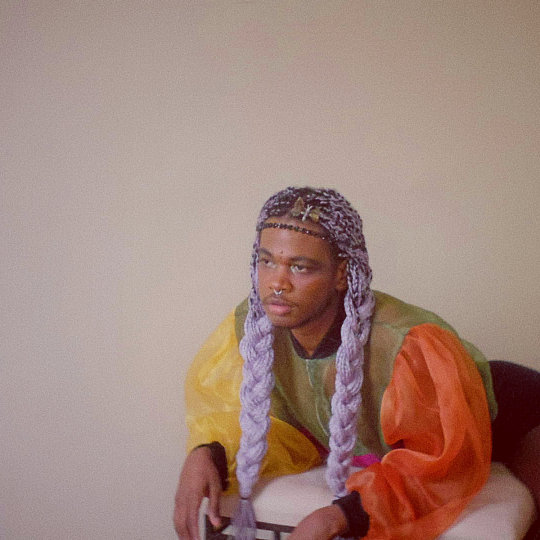
Shamir - Shamir (self-released)
Shamir’s voice is a bright beacon in a sea of conventional singers. Shamir captures the effervescence of pop music and weaves it together with elements of country, alt rock, and diary confessional lyrics all supported by the emotion and range of his vocals. There’s something for everyone across the album’s 11 shimmering tracks. Lead single and opener “On My Own” feels like a declaration of self and self-sufficiency, an anthem of a breakup song. The almost pop-punk bounce of “Pretty When I’m Sad”, paired perfectly with lines like the angst-ridden, “Let’s fuck around inside each other’s heads,” feels impossible to not bop along to. The twang of “Other Side” would put a country crooner to shame. That’s the power of Shamir. His voice has the ability to smoothly convey joy, resilience, and humor. He uses elements of several genres, not just the dance-pop of his debut, to build a unique album that gives listeners so much to sift through and, of course, dance to. - LL
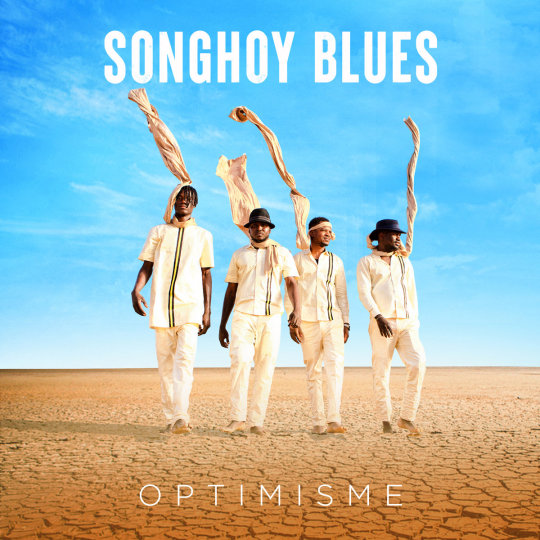
Songhoy Blues - Optimisme (Fat Possum)
If Songhoy Blues’ second album Resistance lacked “the grit of its predecessor,” it’s clear from the hard rock stomp of the opening track of Malian band’s third album Optimisme that they rediscovered their mojo. More importantly, they couple this maximal brashness with tributes to those who make their world a better place: fighters for freedom, women, the young. It’s perhaps the first Songhoy Blues record to truly combine the celebratory nature of their desert blues with a balanced mixture of idealism and vigor. - JM
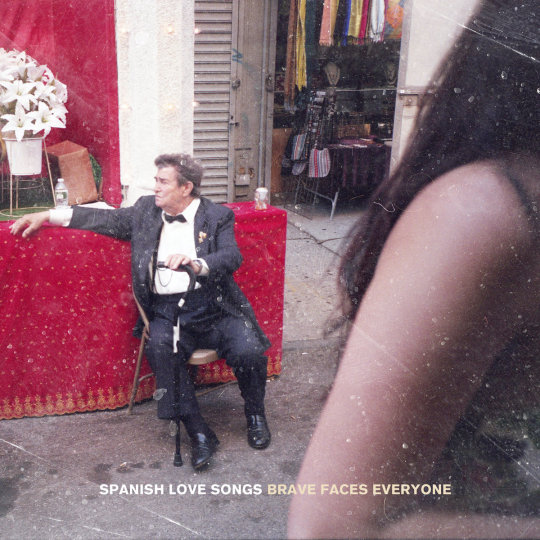
Spanish Love Songs - Brave Faces Everyone (Pure Noise)
How can you find hope in hopelessness, or optimism when every news story points to cruelty? Is it naïve to keep searching for light in the dark? I don’t think so, and I don’t think Spanish Love Songs does, either. I’d like to think we both believe that’s not naivety, but power. It’s the embers you need to really ignite a flame. After all, this is the band with a song titled “Optimism (As a Radical Life Choice)”. It’s a band whose crunching guitars and earnestness insist that despite death and depression and addiction, the instinct to survive shines brightly above all. That relentless hope resurfaces across Brave Faces Everyone’s 10 tracks even as it works through the bleakness of everyday life. - LL
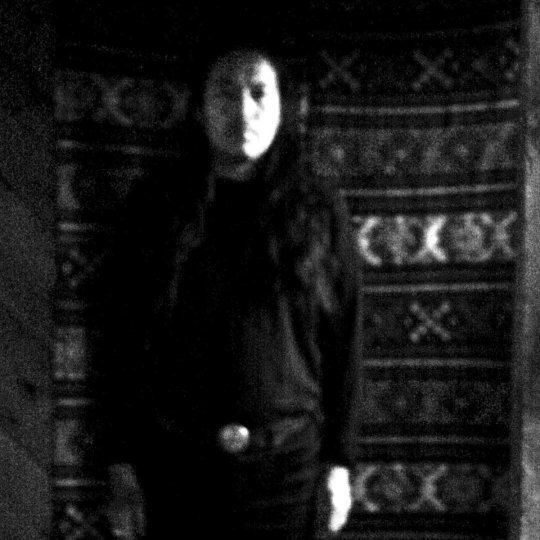
Tashi Dorji - Stateless (Drag City)
The magnum opus from the Asheville-based picker is a group of evocatively titled, disorderly songs about the desolate hellscape of America for outsiders and immigrants. Enigmatic in its nature, not exactly narrative, Stateless combines Dorji’s urgent strumming with moody motifs, captured beautifully in a studio setting for maximum emotional wallop. - JM

Touche Amore - Lament (Epitaph)
Is this what an almost uplifting Touche Amore album sounds like? It’s cathartic in a newer way for the band, especially after the beautifully rendered grief of Stage Four. Lament loses none of the band’s aggression or urgency. “Come Heroine” thrusts listeners into that urgency and introduces a moment of warmth, Jeremy Bolm’s vocals still rasping and insistent: “You brought me in / You took to me / And reversed the atrophy.” The bounciness of “Reminders” may seem close to optimism, but a sharper look at the lyrics uncovers more than blindly looking to the things that bring joy. “I’ll Be Your Host” is reflective, a few years removed from Touche Amore’s previous album and the immediacy of loss, self-aware and growing, but still raw. The album closer, “A Forecast”, takes a turn, a lone voice and piano acting as a confessional before giving way to thrashing guitars and the realization that growth and reckoning with trauma doesn’t mean minimizing it. It means learning to keep moving forward and to stop for help when you may need it. - LL
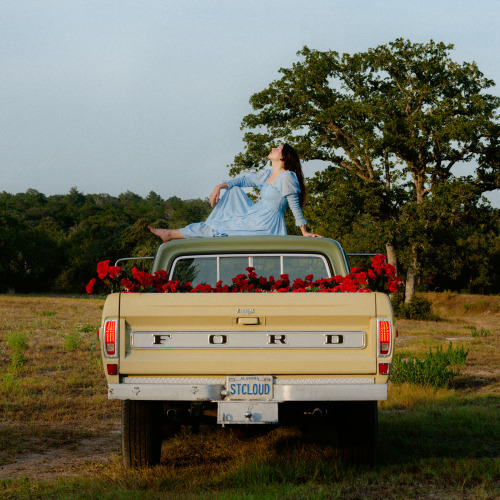
Waxahatchee - Saint Cloud (Merge)
The best album yet from Katie Crutchfield is inspired by positive personal change (getting sober, dealing with codependency issues, her blossoming love with singer-songwriter Kevin Morby) and reflections on family and friends. Named after the suburb of Orlando where her father’s from, Saint Cloud is a genre-hopping collection of stories and feelings that doesn’t necessarily follow any semblance of narrative. On opener “Oxbow” and country-tinged ditty “Can’t Do Much”, Crutchfield’s increasingly aware of the need to pick your side and your battles, whether in the relationship between two people or between the allure of the bottle and the next-day hangover. Some of the best songs on the album see her finding commonalities with others as a means towards self-love. Gentle strummer “The Eye” refers to her natural creative relationships with Morby and her sister Allison. “War” she wrote for herself and best friend, who is also sober, the title a metaphor for one’s fight to remain substance-free. “Witches” is an ode to her best friends, including Allison and Snail Mail’s Lindsey Jordan, all equally frustrated by the toxic nature of the music industry and the world at large, ultimately lifting each other up because they simply have each other.
Read our full review here.
#autechre#against all logic#bartees strange#charli xcx#christine and the queens#dogleg#dua lipa#emma ruth rundle & thou#fiona apple#haim#irreversible entanglements#jeff parker#jeff rosenstock#jessie ware#laura marling#les amazones d'afrique#lianne la havas#lomelda#moses sumney#norah jones#phoebe bridgers#pj harvey#porridge radio#sault#shamir#songhoy blues#spanish love songs#tashi dorji#touche amore#waxahatchee
66 notes
·
View notes
Text
Omaggio a Dante: La Firenze di Cacciaguida
In occasione del 750° anniversario della nascita di Dante “tuttatoscana” Dante e Beatrice. Codice Egerton, metà sec. XIV, Londra, British Library pubblicherà periodicamente nel corso dell’anno brani commentati tratti dalla Divina Commedia riguardanti la città di Firenze e i suoi abitanti. «O sanguis meus, o superinfusagratïa Deï, sicut tibi cuibis unquam celi ianüa reclusa?». Con queste…

View On WordPress
#Dante Cacciaguida Paradiso XV#La Firenze di Cacciaguida#Toscana curiosità#Tribute to Dante Alighieri
0 notes
Text
In reality, Dante loved Beatrice from a distance and they had little to no contact with one another. The real Beatrice Portinari probably never had any idea of the depth of his passion for her. Yet she was to become one of literature’s most famous figures.
Dante Alighieri first saw and fell in love with Beatrice when he was nine years old. He would later write about his instant love for her in Vita Nuova, saying “Behold, a deity stronger than I; who coming, shall rule over me.” He loved her from afar for the rest of her life. She would die in 1290 at age twenty four.

Beatrice is more than a simple muse. She is an idealized love, the kind of love that transcends physicality. Alighieri included her in both La Vita Nuova and Divine Comedy. She is his salvation; the “gentilissima” (most kind) and “benedetta” (blessed). It is Beatrice who serves as his guide in Heaven in Divine Comedy.
Any discussion of Pre-Raphaelite works of Dante and Beatrice is dominated by the paintings of Dante Gabriel Rossetti. The influence of Dante Alighieri was Gabriel’s birthright; he was an inescapable ghost in the Rossetti home. His father, Professor Gabriele Rossetti, was a Dantean scholar whose obsession for finding Masonic allusions in the works of Dante became his life’s fixation. Although in his younger years, Dante Gabriel Rossetti preferred English writers such as Shakespeare and Sir Walter Scott, Dante Alighieri seems to have been absorbed into Gabriel’s DNA and became a frequent subject of his work. Gabriel would later translate Dante’s Vita Nuova and his own personal life and relationship with Elizabeth Siddal, the model/painter who would later become his wife, seemed at times to parallel Dante’s love for Beatrice.
In Rossetti’s 1855 watercolor of Beatrice meeting Dante at a marriage feast, we can see Elizabeth Siddal’s features as Beatrice. At this point, Siddal was Rossetti’s muse and the primary female face seen in his work. In this watercolor, Rossetti illustrates a passage from Vita Nuova:
I began to feel a faintness and a throbbing at my left side, which soon took possession of my whole body. Whereupon I remember that I covertly leaned back unto a painting that ran round the walls of that house; and being fearful lest my trembling should be discerned of them, I lifted mine eyes to look upon those ladies, and then first perceived among them the excellent Beatrice. And when I perceived her, all my senses were overpowered by the great lordship that Love obtained, finding himself so near unto that most gracious being, until nothing but the spirits of sight remained to me.
Elizabeth Siddal was discovered by artist Walter Deverell while she worked in a millinery shop. After posing for Deverell’s Twelfth Night, she began to model for other Pre-Raphaelite artists, including Rossetti. Upon learning that she also had artistic intentions, Rossetti took her on as a pupil and from then on, she posed only for him. This led to what would be an important yet complex relationship for both and they married ten years later. Rossetti confided to artist Ford Madox Brown that when he first saw Lizzie, he felt ‘his destiny was defined’. This sense of destiny may not have been the literal truth, but it illustrates his efforts to identify Lizzie with the type of love Dante had for Beatrice. It may have been that Rossetti so identified with Dante that he mimicked his relationship with Beatrice, casting Lizzie as the ideal woman and declaring her to be his artistic muse. For more on their relationship, see my previous post Pre-Raphaelite Marriages: Dante Gabriel Rossetti and Elizabeth Siddal.
Siddal’s features can also be seen in The Meeting of Dante and Beatrice in Paradise.
Rossetti was influenced by Dante’s Beatrice and Poe’s The Raven when he wroteThe Blessed Damozel. This idea of love after death would take on a deeper meaning after the untimely passing of Elizabeth Siddal from a Laudanum overdose. His identifying with Dante had reached a frightening new level. With his wife no longer a living muse she becomes an even more Beatrice-like figure, unreachable in the after-life. In his posthumous tribute to her, he painted her as Beatrice on the brink of death.
In the background of Beata Beatrix, we see the figure of Dante and the allegorical figure of Love.
Rossetti painted Jane Morris as Beatrice in this uncharacteristically simple work. Devoid of his usual props, flowers, and symbolism, Rossetti casts Jane as the role once held by his wife. Note the spiral hair pin.
Jane Morris appears again as Beatrice in The Salutation of Beatrice. It seems that as much as Rossetti had always longed for the idealized love he had for Lizzie Siddal, he needed an earthly love as well. Siddal’s existence may have seemed to be a fulfillment of the love he wrote about in The Blessed Damozel, but it was not enough to sustain him. Throughout the course of his life, he had passions for other women, including model Fanny Cornforth, Siddal, and Jane Morris. Each of these loves had undeniable influence on his work and style.
There are so many Rossetti works inspired by Dante that I certainly can not include them all here in this blog post. But I do have to share another of Rossetti’s paintings of Beatrice that I find to be quite beautiful. It has lighter tones and a delicate, floral motif. In short, this is the type of Rossetti I love. Jane Morris as a goddess-like figure as only Rossetti can capture her, similar to my other Rossetti loves: The Day-Dream, Proserpine, and Astarte Syriaca.
The largest of Rossetti’s Dantean works is Dante’s Dream, a representation of Dante dreaming of Beatrice’s death in Vita Nuova. Notice the poppies scattered on the floor. Jane Morris appears as Beatrice, although Rossetti has given her Elizabeth Siddal’s red hair
Other Pre-Raphaelite and Victorian artists created works inspired by Dante’s unrequited love for Beatrice.
Simeon Solomon was definitely influenced by Pre-Raphaelitism, and Rossetti’s influence can be seen in his drawing of Dante meeting Beatrice.
Henry Holiday, who on his death was described as “the last Pre-Raphaelite” painted Dante and Beatrice in 1883-4. He traveled to Florence in order to achieve accuracy in his work and I have to say that I find the architecture impressive.
Marie Spartali Stillman studied under Ford Madox Brown and in 1867, she became a friend of Dante Gabriel Rossetti as well. That friendship helped inspire her paintings of Dante. In the late 1870s, Spartali Stillman moved to Florence and living there influenced many Italianate works, some of which were inspired by not only classical sources, but Dante Gabriel Rossetti’s Early Italian Poets.
John William Waterhouse painted Dante and Beatrice in 1915
It is easy to forget that Beatrice was a real woman. Of course, we know nothing at all about her apart from Dante’s obsession with her. What were her passions, her fears, her loves? She may have died at twenty-four, but she has achieved literary immortality.What can we in the 21st Century learn from Dante and Beatrice? The fact is, our society seems to have forgotten that there are many forms of love. Dante’s love for Beatrice may have been idealized and unattainable, but at the core of that love is admiration, goodness, and respect. That’s a type of love that you don’t see much of in the media of today’s world. We prize the scintillating and love has become synonymous with physical lust. Dante’s love transcends the physical. It is a love of the heart and the intellect. Treasuring the people in your life that inspire us intellectually, prompting us to be the best version of ourselves that we can be? That’s something for us all to aspire to.
“O human race, born to fly upward, wherefore at a little wind dost thou so fall?”–Dante Alighieri, The Divine Comedy





6 notes
·
View notes
Text

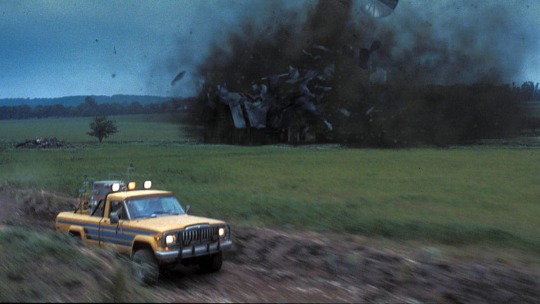



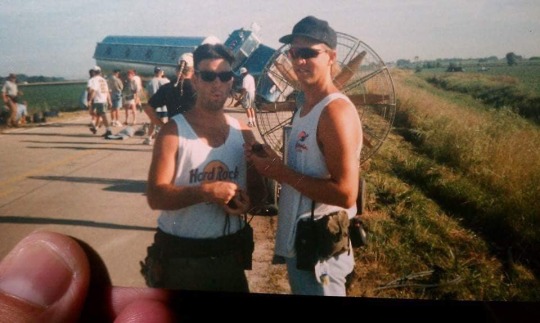
Twist 那個油罐車竟然是實景拍攝
電影
Crew Stories 昨天上午11:41 ·
On this day in 1996 Twister was released "That's no moon, it's a space station!" Tom Hanks was the original choice for the role of Bill Harding. Hanks read lines with the cast and even chose the character's wardrobe, which stayed in the final film, before dropping out. Kurt Russell and Michael Keaton were other possible considerations. Bill Paxton was chosen due to his "southern everyman charm" on a recommendation from director James Cameron. Another James Cameron connection is the name on the tanker truck that pushes Bill's pickup off of the tree is "Benthic Petroleum" which is the same oil company that Ed Harris' crew works for in The Abyss (1989). The base camp (where the crew trucks and equipment are staged) for the end sequence was at a pig farm down the road from the well-house. Every morning the cast and crew were greeted by the smell of a 2-acre pig-waste holding pond in the middle of all the trucks. 2nd AD Richard Oswald shared with us that the legendary Newt Arnold, was the 1st AD would do a loud Tarzan howl when camera was ready! During the hot summer shoot the crew went thru tons of Gold Bond for their “nether region” during dustings at lunch. Crew stories member Jeff Machit shared this anecdote about his experience on the film, my favorite Twister moment. “We’re working in the middle of tornado alley during the middle of tornado season. Many of the crew were concerned about what to do if we were threatened by a real twister. Production brought in the local TV weather man to reassure us. He told us not to worry as we have an on site Doppler radar. The radar would give us a 15 minute warning. He also reassured us that there were two helicopters standing by to evacuate all the above-the-line personnel. The rest of crew should find a ditch to jump into.” Some crew members, feeling that De Bont was "out of control", left the production five weeks into filming. The camera crew led by cinematographer Don Burgess ASC claimed De Bont "didn't know what he wanted till he saw it. He would shoot one direction, with all the equipment behind the view of the camera, and then he'd want to shoot in the other direction right away and we'd have to move [everything] and he'd get angry that we took too long ... and it was always everybody else's fault, never his". De Bont claims that they had to schedule at least three scenes every day because the weather changed so often, and "Don had trouble adjusting to that". When De Bont threw down a camera assistant in a fit of rage, Burgess and his crew had enough and walked off the set, much to the shock of the cast. I just talked to the AC now a operator and he shared this with us. “Looking back on it, I wish I had the self confidence and awareness to make an official complaint to the studio. But I was 32 years old with two young kids and I was afraid it would affect my ability to find work. Obviously, those were different times.” The camera grip and electric crew remained in place for one more week until cinematographer Jack N. Green's crew agreed to replace them. Unfortunately with just two days left of principal photography Jack Green was injured on stage, a warehouse. The set was built so the second floor would drop. It was very hot and there was air conditioning that was very loud. A test of the floor dropping was going to be done. The 1st AD called it out. Jack was underneath and because of the air conditioning didn’t hear the warning. Jack was instructing lamp operator Matt Hawkins to adjust a light and in doing so moved him out of harms way. Unfortunately for Jack the dropping floor hit him injuring his back. Jack spent some time in the hospital. Jan De Bont took over cinematography duties for the remainder of the shoot. Halfway through filming, both Bill Paxton and Helen Hunt were temporarily blinded by bright electronic lamps used to make the sky behind the two actors look dark and stormy. Paxton remembers that "these things literally sunburned our eyeballs. I got back to my room, I couldn't see". To solve the problem, a Plexiglas filter was placed in front of the
beams. The actors took eye drops and wore special glasses for a few days to recuperate. After filming in a particularly unsanitary ditch (for the first tornado chase scene, in which Bill and Jo are forced to shelter from an approaching F1 tornado under a short bridge), Hunt and Paxton needed hepatitis shots. During the same sequence, Hunt repeatedly hit her head on a low wooden bridge, so exhausted from the demanding shoot that she stood up so quickly her head struck a beam. During one stunt in which Hunt opened the door of a vehicle speeding through a cornfield, she momentarily let go of the door and it struck her on the side of the head. Some sources claim she received a concussion in the incident. De Bont said, "I love Helen to death, but you know, she can be also a little bit clumsy. " She responded, "Clumsy? The guy burned my retinas, but I'm clumsy ... I thought I was a good sport. I don't know ultimately if Jan chalks me up as that or not, but one would hope so". To simulate the high speed winds that occurs during a tornado and Ritter fans weren’t enough special effects Legend John Frazier and his effects crew (the real heroes of this production) procured some jet engines from a Boeing 707 and mounted them to flatbed trailer! This crew pulled off some pretty epic stuff on this one from dropping tractors from cranes and helicopters to driving a truck thru the facade of a tumbling house! The instrument package used in the movie, "Dorothy", is an homage to the instrument pack real tornado researchers attempt to place in the paths of tornadoes, "T.O.T.O.". Lois Smith's character is reading Dante Alighieri's Inferno when the twister hits Wakita. The book also features a tornado in the second circle of Hell that punishes people ruled by Lust. After the team leaves Wakita, there is a seemingly impossible helicopter shot in which the camera descends several hundred feet in a matter of seconds, ending up mere feet from Jonas's convoy. This was achieved by having the cars drive slower than usual and then speeding up the film. A recording of a camel's moan was slowed down and used as the sound of the tornado. Although Amblin Entertainment has collaborated with both Warner Bros. and Universal on many occasions (Amblin co-founder Steven Spielberg directed films for both studios), as of 2014, this film marks the only time Amblin collaborated with both studios on the same film. The real town of Wakita, Oklahoma had part of its old downtown area demolished by the film crew for the scenes after the twister passes. The studio then paid for the downtown to be rebuilt. The town also kept the new fire truck used in the film De Bont insisted on using multiple cameras, which led to the exposure of 1,300,000 feet (400,000 m) of film, compared to the usual maximum of 300,000 feet (91,000 m). The 35mm short ends were used to shoot Jon Favreau’s SWINGERS. pre production in Oklahoma was briefly delayed due to the bombing of the Alfred P. Murrah Federal Building in Oklahoma City on April 19, 1995. Many of the crew went to the site to help with recovery efforts. This was the first movie released on DVD, and the last released on HD-DVD. After Bill Paxton died, Spotter Network choreographed 200 storm chasers to spell out "BP" with their GPS tracker blips on a radar display to honor him. This kind of tribute had only been done five times before, and it was the first time it had been done for someone who wasn't a storm chaser. (IMDb/Wikipedia/crew stories) some photos from Sound utility and crew stories member Robert K. Maxfield and Paxtonmobile by Mel Roswell,excerpts from a previous post from Matt Hawkins, Jim Plannette, Richard Oswald If you recognize any crew members comment so we may update. A special Thank you to every crew member that endured this production, you were deep in the suck and it was worth it! These kinds of popcorn movies inspired many of us to pursue a career in the filmmaking process.
1 note
·
View note
Text
A New Lease on Life 1: Amber or Kimber?

This chapter dedicated to Larry Niven and Jerry Pournelle, authors of "Inferno," a modern fictional tribute to Dante Alighieri's Inferno. That book's totally worth a read even if you're not a major nerd—like me—even though the sequel sucked.
Trigger warnings: Language, suggestive language, panic attacks, insensitive remarks.
Suggested Listening: The Rasmus, "No Fear"
---------------------------------------
1: Amber or Kimber?
---------------------------------------
New York City, January 27th, 2016
The first thing Amber noticed was cold; the second was muffled noises almost like speech, followed by a stabbing ache right above her eyes. After all, she'd received a blow to the head…hadn't she? Details weren't coming to her in that state halfway between sleep and wakefulness. As the throbbing in her head smoothed out, she scoured her memory for answers—answers she couldn't find in the blur that her past had become. Only one thing stood out among the blank space in her history….
She was dead. How she knew this, she wasn't completely sure, but as the headache faded away, fractured memories slowly filled its place. Willsdale—the storm of the century—the school where she'd worked, torn and trashed by EF-5 level winds. Her eyes flew open in fear, searching for any sign of light or life. Blinded by a sudden light, she cringed into the foul smelling heap she lay on. The voices around her grew louder and less muted, then suddenly ceased all together.
Where was she? What happened? How had she found herself in the situation she was in—what was the situation, even? She had no answers—not even the strength to lift her head. Out of the blue, she felt a presence beside her…warm, gentle arms drew her closer and wrapped her in a cocoon of scratchy warmth. This, she could get used to, she mused weakly as she turned to nuzzle into the warm shoulder propping her up.
But nothing good ever lasts…as though summoned by her comfort and calm, a demon she knew too well manifested with a grinding roar. The slow trickle of memories became a torrential downpour—horrifying images flooded her delirious mind. Somewhere in the distance, someone was screaming, screaming as though they were being slowly gutted. The world turned sideways and crossways as the warmth surrounding her fell away; again, she fell to the fetid ground wishing the screaming would stop, wishing the memories would cease. Someone shut it all off, she cried soundlessly, her vocal chords inexplicably stilled.
A pinprick pain sprang to life, quickly becoming a spreading fire. On the heels of the fire, murky fog rolled in, choking out the life replaying before her sightless eyes. She struggled to get her head above water, struggled to breathe. A soft, gentle touch brushed from her brow to her temple then trailed along the line of her cheekbone. Sometime between the beginning of the caress and the whispering that followed, Amber's distorted world was swallowed up by a black void.
New York City, April's loft, January 28th, 2016
"I'm not so sure of this, Casey," a soft voice murmured nearby. Amber twitched at the sound, disoriented and bewildered. She'd died—she remembered now, remembered being in another place—a place of endless nothing set to the sound of a clock's incessant ticking. Limbo, she wondered wearily? "We should've taken her to the hospital—she could be dangerously sick!"
"Hon, ya know we can't," a deeper voice replied. "If she wakes up an' starts jabberin' about giant turtles, it'll be trouble for da guys!"
'Giant turtles?' Amber thought groggily. 'Great, out'a the'afterlife an' into the nut house. At least it's warm, here…an' it smells nice, too.' She burrowed deeper under the scratchy knit afghan with a contented sigh, relishing the sweet fragrance of spiced cider. Later she'd question how she could be alive when she was sure she'd died but for now, she was too comfy to care, even with a splitting headache.
"Hey, she's waking up!" the first voice hissed; damn, no rest for the wicked. "Miss, you okay? You need anything?" Reluctantly, Amber pried open her eyes, fumbling blindly for her glasses; a blurry hand passed them to her and she affixed them to her face, working her way to a sitting position. A woman with dark curly hair hovered before her with a steaming mug of cider and a concerned expression. As Amber finally trudged the rest of the way to life, she reached to scratch her left knee…and found bare skin. Startled awake by the absent clothing, she glanced down at herself in dismay.
Not only were her surprisingly toned legs nearly bare, most of her was bare! The skirt she'd woken in barely qualified as 'mini,' the skimpy top was cut so low her suddenly larger and firmer breasts seemed about to pop out, she was clearly not wearing a bra, and the clunky black boots she wore seemed more for looks than use. The fact that she had somehow lost almost a quarter of her body weight was shoved firmly into a vacant corner of her mind to be dealt with when she wasn't practically naked. Her cheeks flamed bright red as she yanked the afghan up to cover herself up to the chin. "Miss?" April asked in confusion.
"Please tell me I'm not a hooker!" Amber blurted desperately.
"What?" Casey gaped. Undeterred, Amber rambled on in disgust and panic.
"This's so not me—I'm barin' more than I'm wearin'! There should not be a fuckin' draft there, an' I'd never be caught dead wearin' a screw-me skirt. Granted, I like the hoochie boots an' my boobs finally match my ass, but for the love of Mike I'm practic'ly naked!" When she finally realized everything she'd said, she cringed. "Eheh…Sorry…brain-to-mouth filter malfunction."
"I'll say," Casey grinned; April shot him a dirty look, but he just shrugged. "So what's ya name, Miss Not-a-hookuh?"
"Amber," she replied nervously. "Amber O'Brien. An' Y'all?" The other two blinked at the blatant twang in her voice. Was it really so odd, she wondered? The vast majority of her hometown spoke with a much thicker twang than she did, so how could they be so surprised by it?
"I'm April O'Neil," the other woman replied politely as she handed Amber the mug of cider. "This is my boyfriend, Casey Jones." It took a moment for the facts to sink in.
'You're kiddin' me, right?' Amber thought sarcastically. 'What're the odds that I'd die an' wake up in the middle of a movie set?' Instead of acknowledging the elephant in the room, she asked, "Train conductor or Grateful Dead?" Their response was a blank stare. "Sorry. So…uh…how'd I wind up here? Did y'all knock me out'a that jar in the vestibule—or were the jars in Limbo?" She frowned down at the cider searching her scattered memories.
"What jar?" April was at a loss. "Some…friends of ours found you in an abandoned subway station. You were freezing to death. Do you not remember that?" Amber searched her memories, then shook her head with a confused frown.
"No, my memory's…kinda blurry," she admitted. "I remember…a storm…a bad one, worse than I'd ever…" Unbeknownst to her, her words became more and more frantic and stammered, her eyes grew wild, and she started shaking violently. Amber never noticed any of it; next thing she knew, she found herself on the floor in the corner curled in a tiny ball with April petting her hair. "…Wha…What happened?" she asked groggily. The pity in April's eyes annoyed her, but she needed answers.
"Do you have a history of panic attacks?" the reporter asked gently.
"No…I've got a pretty bad phobia so I've had anxiety attacks, but it's never anythin' serious. Why?"
"Well, now you do. Come on, let's get you into something more…covering." As Amber hoisted herself to her feet, her top dipped lower than before, revealing a flash of purple and black. Startled by the sight, Amber never noticed the shocked gasps of her hosts; she was too busy staring in dismay at the coiled purple dragon tattoo nestled in her cleavage.
"We got here as soon as we could," Leo apologized as he climbed over the windowsill. Donatello followed right behind, silently hanging his trench coat on the rack next to Leo's overcoat. "Has she made any progress?" April's worried, tight-lipped frown concerned him, and Casey's frustrated pacing wasn't reassuring either.
"Ya know anythin' about dis chick?" Casey muttered, shooting a glare at April's bedroom door; not long after the tattoo's discovery April had ushered their stunned guest to bed with a mug of tea, a pair of sweats, and a teeshirt big enough to double as a dress.
"We told you everything we knew, Casey," Don replied. "Too little clothing, no sign of substance abuse, hypothermic and possibly homeless, and nearly had a heart attack right in front of us. Why?"
"She's a dragon!" Casey spat, slamming his fist into the nearest wall.
"Casey!" April scolded. "Cool it!" Even as he shook off flecks of dried paint, he growled under his breath.
"You brought us a fuckin' Purple Dragon, Leo, an' she's clearly off her rocker! She—"
"Wait, back up," Donnie interrupted. "Why do you think she's a Purple Dragon? We didn't see a tattoo!" April blushed and avoided his eyes.
"Ya didn't look down her shirt—it's between her jugs." Leo cringed.
"Y-You're joking, right?" he stammered hopefully. "Please tell me you're joking." Casey shook his head with a dark scowl. "Great. —Donnie, where're you going?" His brother was already trudging down the hall, medkit in hand and a determined pinch to his eyes.
"Gang or not, she needs help," he answered firmly. "We don't know her story and we don't know her, and until we do, I, for one, reserve judgment." Without another word, he slipped through the door. Light from the hallway guided him to the bed and the lump curled up on the very edge of the mattress. The hair strewn messily over April's lumpy pillow was red as fruit punch, but now that it was brushed out and down out of the ridiculous updo from before, warm brown roots shone through—it was definitely dyed, and from the looks of it, with Kool-Aid.
Donnie paused hesitantly in the doorway, studying the sleeping woman. She was curled up in a ball but he recalled her figure with striking clarity. So many women were obsessed with being thin, looking thin, and feeling thin, and hid their bodies under too-large clothing if they weren't thin enough for their liking. This woman wasn't thin—quite the contrary, she was voluptuous, with soft, wide hips, a well-rounded rear, a generous bust, and from the looks of it, some extra softness around her ribs, hips, and thighs. Popular culture would have deemed her weight and body type a flaw, but he'd always admired curves; to him, she was lovely. Lovely, he thought sadly, and very much out of reach. It didn't bear thinking about, he reminded himself; he had a job to do, and more likely than not she'd scream if she ever saw him. They always screamed, really.
Don was pleased to find she'd made progress. Her body temperature had risen to a healthy 98.4, her blood pressure and heart rate were normalized, and the color had returned to her skin. Better yet she was breathing normally and he couldn't detect any wheezing, so she probably hadn't developed pneumonia from the conditions she'd been found in. Confident that she'd make a full recovery he slid his goggles back up over his forehead and brushed her hair away from her neck to seek out her pulse.
A sudden spike in the pulse fluttering against his fingertips drew a concerned frown, then a soft gasp tore him from his thoughts. Slowly, warily, he met her eyes—moss green eyes wide open in astonishment and set off by a blindingly red blush. He swallowed noisily, counting down the seconds to her inevitable freak-out.
'Holy Mama Mary,' Amber thought as the tall turtle's hazel eyes met hers. 'If this is Heaven…' "—I must'a been a Sainte!" she finished under her breath.
"Pardon?" Don asked dubiously, releasing her neck. Amber flushed.
"S-Sorry. Brain-to-mouth filter malfunction, jus' ignore it." Pulling the comforter almost up to her chin she dragged her glasses back over her eyes, cautiously looking him over. "Am I…dead?"
"Nope; you gave it your best shot, though," he replied with a cheeky smile. "Unless something changes, you should make a full recovery. So, what's your name?" She blinked several times, scrunched up her eyes and squinted at him, sat up with the blanket pooling around her, then pinched herself on the cheek…hard.
"Ow!" she yelped, yanking her fingers away from the throbbing flesh. "Nope, not dreamin'. Ya mind…?" Donnie was completely nonplussed but shrugged; without another word, she reached one hand out and poked him squarely in the shoulder. He stared back, clearly questioning her sanity. "A'right, Willis," she announced to the room in general, searching every corner she could see. "Ya win. I won't post that video if ya call off yer buddy. Shame really, it was a hoot."
"Video?" Don asked dubiously. Amber smirked.
"Aaron got shite-faced on Scotch whisky an' tried to milk a bull; it disagreed. Now come on out, Willis, this's getting' annoyin'!"
"Of course," Casey grumbled from the doorway. "Now I recognize ya—dat fake accent threw me off. Donnie? Dis's Kimber Bryant; she hangs out with dat little dweeb Daron Williams."
"Daron Williams?! Kimber Bryant?!" she repeated shrilly. "My name's Amber! Amber O'Brien, an' I've always talked like this! The heck're you smokin'?"
"Quit wit' da lyin' a'ready!" Casey snapped. "Raph an' I busted yer ass 'nuff times fer me ta know ya, 'specially with dat tattoo'a yers!"
"Casey," Donatello warned lowly. "Back off, you're not helping." He turned to the green-eyed woman again, troubled by the confusion in her eyes. Poor thing...she really didn't know who she was? "Amnesia, maybe? What's the last thing you remember?"
She only got out one word—storms—before losing her grip on reality. Right before his eyes she paled and shrunk into herself; her eyes grew wide, her breath sped to gasps and pants, and an endless stream of garbled words fell from her lips. Realizing what was happening, Don dug a bottle of homemade smelling salts* from his kit and waved it under her nose, monitoring her pulse with his other hand. Finally, her glazed-over eyes focused fearfully on his, her voice stilled, and her breathing regulated. "I—"
"It's alright," he soothed as he drew back again. "Whatever happened isn't exactly ready to come to light, apparently. Maybe just some questions? Simple yes or no answers, perhaps?" Though she was only growing more and more confused, she nodded, following him to the living room again, the comforter draped around her like a fluffy yellow cloak. April put on the kettle for tea while the rest settled in the living room.
"Kimber Bryant?" Leo asked bluntly.
"No," she replied seriously. "Amber O'Brien. I was born to Douglas O'Brien and Ginny Devon in Willsdale, Missouri, I graduated Willsdale High in May '94, an' I spent the last several years workin' for the school district as a night janitor at Willsdale High. "
"Do you know where you are?" Donnie suddenly asked. "Do you know what city you're in?" Her face fell.
"They said I was found in a subway station, right?" she asked hesitantly. "The only subway I've ever been in served sandwiches, an' had a gas station attached. So clearly I'm somehow not in Willsdale anymore." A violent shiver wracked her shoulders and she burrowed further into the blanket. "Wherever I am now, it's pretty dang cold fer May even with 2011's freaky weather."
Leo and Donnie exchanged a wary glance. "Miss O'Brien?" Donnie said softly, placing a steadying hand on her shoulder. "You're in New York City; it's January 27th, 2016."
NOTES
*Smelling salts CAN be used for panic attacks, but should be used VERY SPARINGLY and only in conjunction with other coping skills. If you just use salts—or other 'wake up' devices like sour candies or fireball jawbreakers, for example—and never get to the root of the problem, never work on what has given you panic attacks, they become a crutch and can eventually worsen your troubles. I've never used them myself, so I can't recommend salts. I CAN recommend breathing exercises, fireballs and Altoids, and meditation.
Panic attacks CAN be beaten, and you CAN get PTSD under control enough to live a fulfilling life. Don't give up—you're stronger than you give yourself credit for.
#tmnt#Teenage Mutant Ninja Turtles#Ninja Turtles#Donatello#Raphael#Leonardo#Michelangelo#donnie/oc#Raph/OC#Leo/OC#Mikey/OC#Romantic Drama#Non-Sue OCs#A New Lease on Life#ANLoL#Here be plot twists
1 note
·
View note
Text
Tribute 33: Dante Alighieri


13th century Italian poet who wrote the Divine Comedy about his supposed journey through Hell, Purgatory, and Heaven (called Inferno, Purgatorio, and Paradiso)
Because the Bible has very little description of those three places, he made a lot of it up himself
Helped establish Italian as a language through the Divine Comedy; in French, Italian is actually sometimes called "la langue de Dante", or "the language of Dante"
Dante Alighieri Divine Comedy
12 notes
·
View notes
Photo

Beata Beatrix, Dante Gabriel Rossetti, 1871, Art Institute of Chicago: European Painting and Sculpture
Both a poet and a painter, Dante Gabriel Rossetti was a founder of the Pre-Raphaelite Brotherhood, a circle of Victorian artists who were united in their regard for medieval aesthetics. Named after the thirteenth-century poet Dante Alighieri, Rossetti found inspiration for Beata Beatrix in his namesake’s La vita nuova (The New Life; 1295). Rossetti’s scene draws a parallel between Dante’s love for the late Beatrice and his own affection for his recently deceased wife and muse, Elizabeth Siddal. While this picture is a tribute to Siddal, Rossetti was adamant that it does not represent her death. Rather, the work portrays her as if in a trance or altered spiritual state. Rossetti’s symbolism combines details from his personal life with those from La Vita Nuova. “The Dove” was the artist’s nickname for Siddal, and a haloed dove delivers her a white poppy, a symbol of laudanum—a derivative of opium—which caused her death by overdose. Above rises the Ponte Vecchio, the Florentine bridge that served as the setting of Dante’s poem. To the upper left is the personification of Love and to the right the figure of Dante, who doubles as a representation of Rossetti himself. The sundial shadows the number nine, the age Dante first saw Beatrice as well as the hour and day of her death. Rossetti designed the frame, and at the top right he inscribed, “How doth the city sit solitary.” This quote from La Vita Nuova refers to the city of Florence’s mourning of Beatrice. Given the deeply personal nature of the work, Rossetti initially refused his patron William Graham’s request to create a replica, although he eventually yielded. The Art Institute’s painting is this second version, which is the only one to have a predella—the painted scene at the bottom of the frame—depicting Beatrice and Dante’s reunion in paradise. With this addition, Rossetti provides the medieval love story with a happy conclusion, perhaps suggesting that he, too, had begun to come to terms with his own profound grief. Charles L. Hutchinson Collection Size: 87.5 × 69.3 cm (34 7/16 × 27 1/4 in.) Predella: 26.5 × 69.2 cm Medium: Oil on canvas
https://www.artic.edu/artworks/16551/
8 notes
·
View notes
Text
La Toscana nelle pagine della Divina Commedia (metafore e paesaggi)
Quante immagini di Toscana nei versi del sommo poeta! a cura di Alessandro Ferrini La selva dei suicidi La selva dei suicidi (incisione di Gustave Dorè) Non fronda verde, ma di color fosco;non rami schietti, ma nodosi e ‘nvolti;non pomi v’eran, ma stecchi con tòsco. Non han sì aspri sterpi né sì foltiquelle fiere selvagge che ‘n odio hannotra Cecina e Corneto i luoghi cólti. Inf. XIII,…

View On WordPress
#Alessandro Ferrini La Toscana nelle pagine della Divina Commedia#Divina Commedia metafore e paesaggi#Immagini di Toscana nei versi#Tribute to Dante Alighieri
0 notes